30+ Fascinating Photos That Captured The Collapse Of Nazi Germany In 1945
Nazi Germany, officially known as the German Reich and later the Greater German Reich was the German state from 1933 to 1945 under Adolf Hitler and the Nazi Party. They transformed the country into a totalitarian dictatorship.
The term “Third Reich,” meaning “Third Realm” or “Third Empire,” signified Nazi Germany’s claim to be the successor to the Holy Roman Empire (800–1806) and the German Empire (1871–1918).
The Nazis referred to their regime as the Thousand-Year Reich, though it ended after just 12 years. The final days of Nazi Germany were chaotic and marked by intense conflict as Allied forces converged on Berlin.
Hitler’s suicide in the bunker
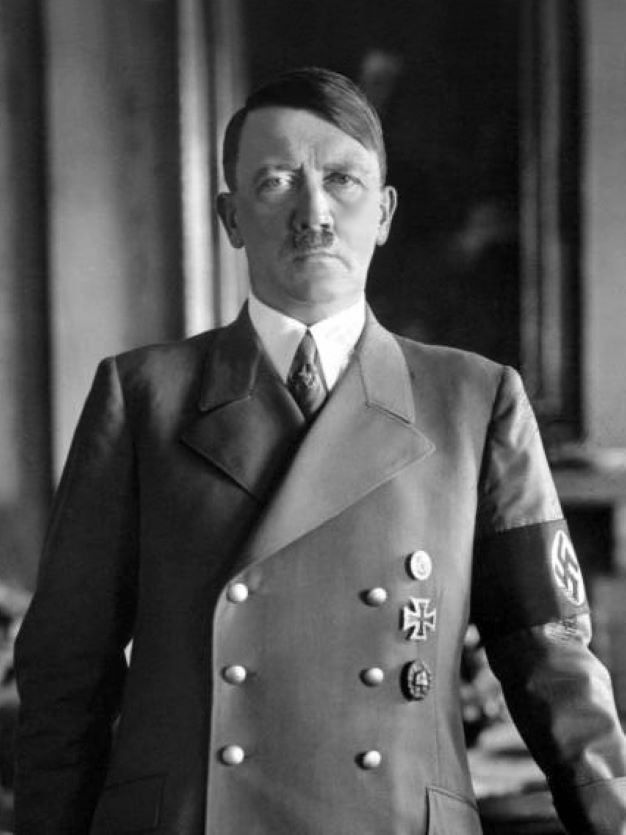
On April 30, 1945, as the Battle of Nuremberg and the Battle of Hamburg concluded with American and British occupation and with the Battle of Berlin raging above him, Adolf Hitler faced a dire situation.
The Soviets had surrounded Berlin, and the Americans had cut off his escape route. Realizing that defeat was inevitable and not wishing to meet the same fate as Mussolini, Hitler decided to take his own life.
He committed suicide in his Führerbunker alongside Eva Braun, his long-term partner, whom he had married just 40 hours earlier.
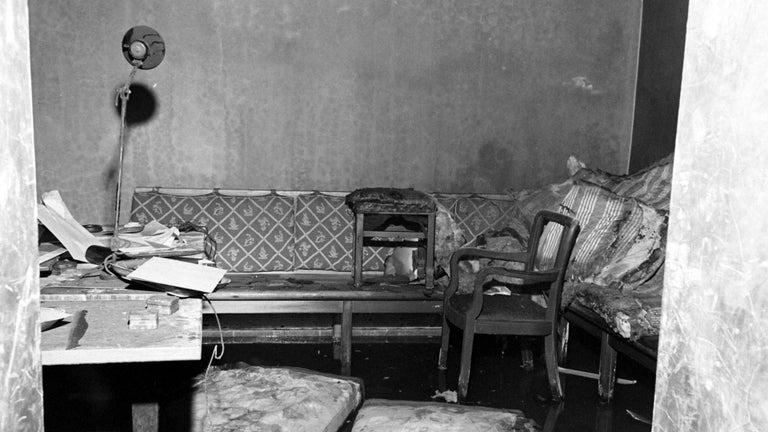
In his will, Hitler dismissed Hermann Göring and Heinrich Himmler, who had attempted to seize control. He appointed Großadmiral Karl Dönitz as President of Germany and Joseph Goebbels as Chancellor.
However, Goebbels also died by suicide the next day, leaving Dönitz as the sole leader of Germany.
Final battle in Berlin
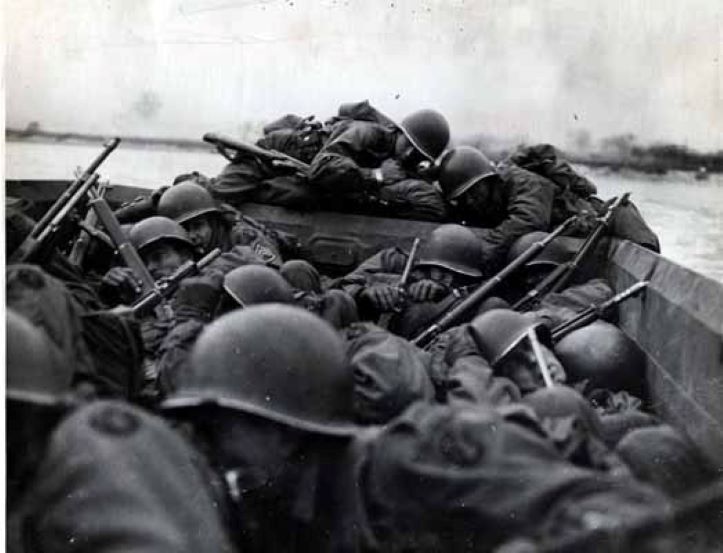
By early 1945, the war Germany had started was now consuming the country itself. Unlike in 1918, Germany fought relentlessly to the very end.
Even as defeat became certain, the Germans continued to resist, not surrendering even when Soviet soldiers reached the Reich Chancellery in Berlin.
In March, Western Allied forces crossed the Rhine River, capturing countless German troops from Army Group B.

Meanwhile, the Red Army entered Austria, and both fronts quickly advanced towards Berlin. Allied strategic bombing campaigns devastated German cities, sometimes wiping out entire areas in a single night.
In the first few months of 1945, Germany mounted a vigorous defense but quickly lost territory, ran out of supplies, and exhausted all options.
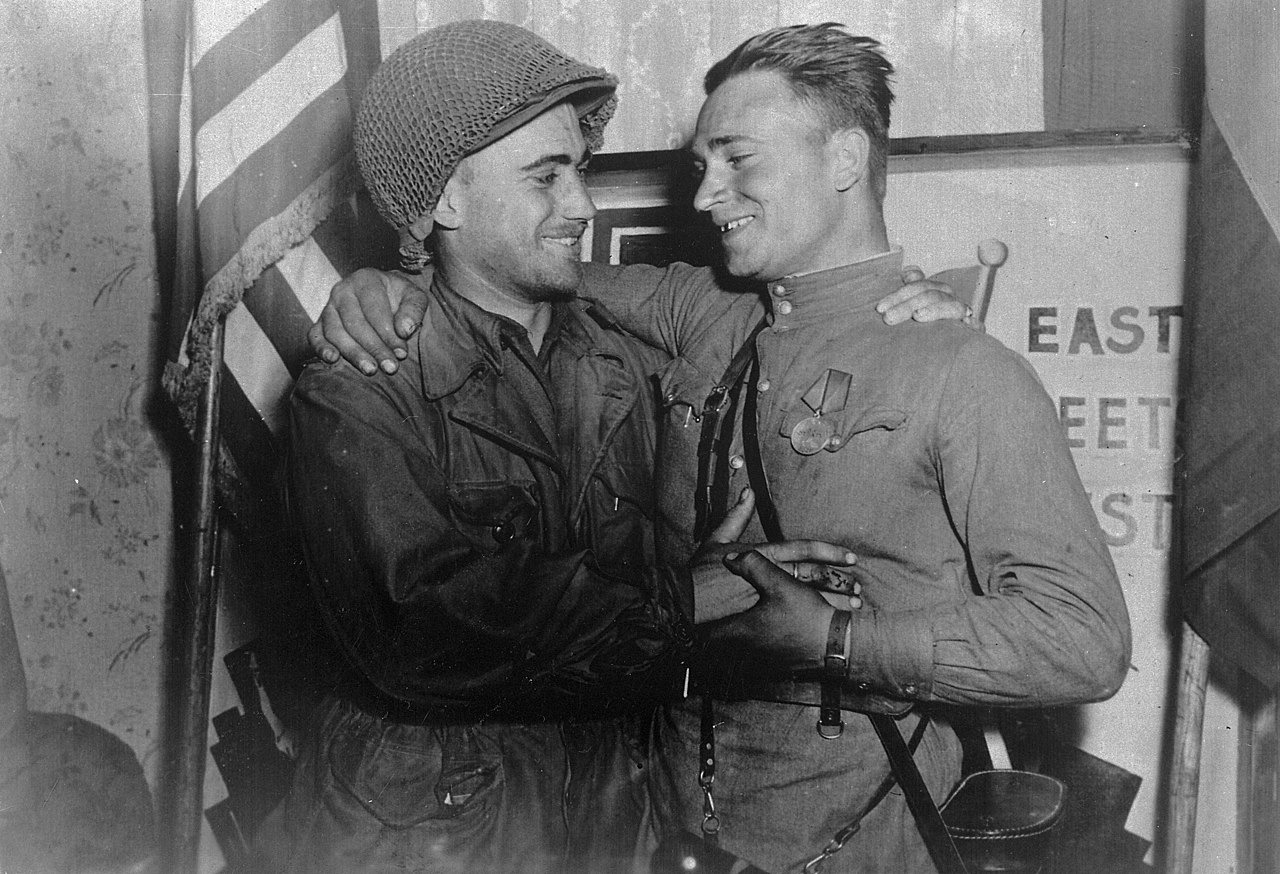
In April, Allied forces broke through German defenses in Italy. On April 25, Soviet and American troops met at the River Elbe near Torgau, Germany, marking a significant milestone.
On April 30, as Russian troops entered Berlin, Adolf Hitler committed suicide. Joseph Goebbels briefly took over leadership but also took his own life within 24 hours. Other Nazi leaders were either captured by the Allies or on the run as fugitives.
Germany’s unconditional surrender
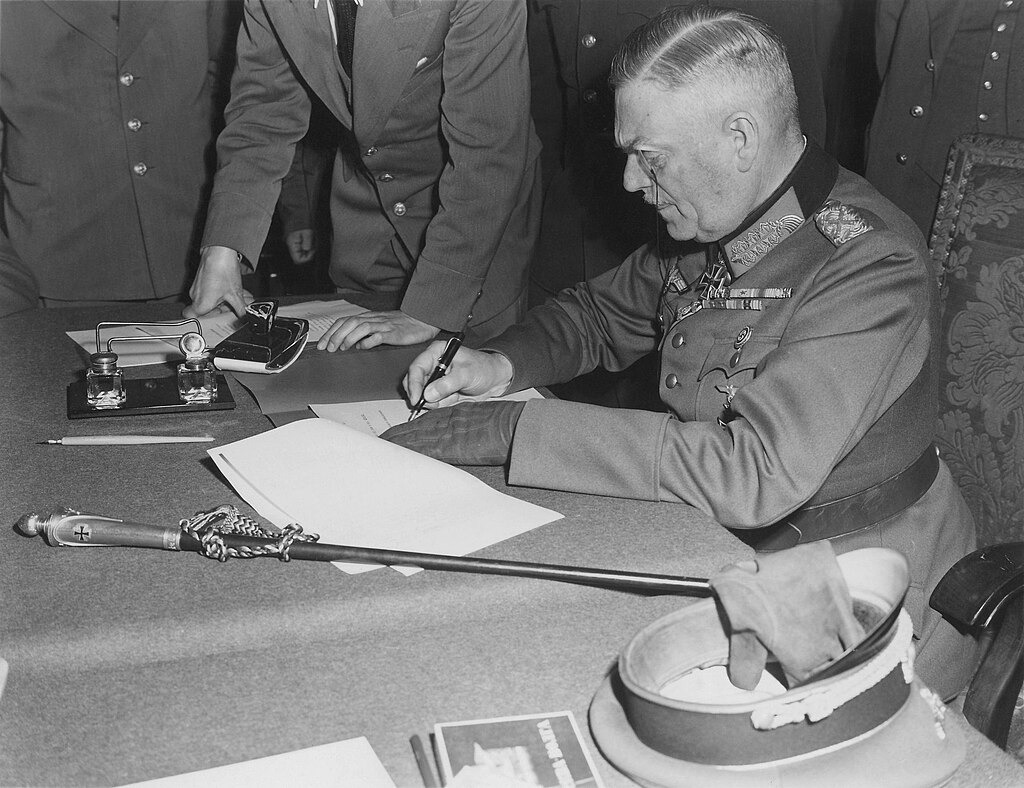
On April 29, 1945, German forces in Italy agreed to surrender. The surrender document, signed after secret negotiations, led to nearly 1,000,000 troops in Italy and Austria surrendering unconditionally on May 2, 1945.
The Battle of Berlin ended on May 2, 1945, when General Helmuth Weidling surrendered the city to the Soviet Army. On the same day, two other German generals surrendered to the Western Allies. Hitler’s deputy, Martin Bormann, likely died on this day.
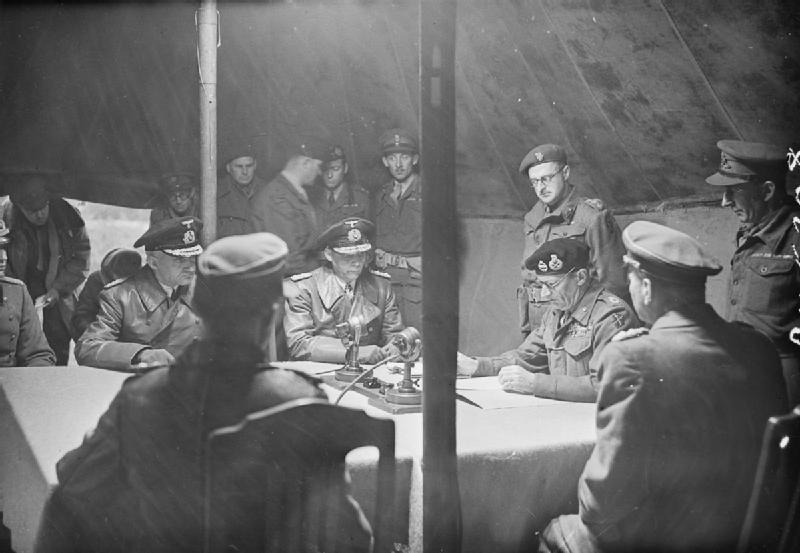
On May 4, 1945, German forces in northwest Germany, Denmark, and the Netherlands surrendered to British Field Marshal Bernard Montgomery, involving around 1,000,000 troops.
The following day, U-boats ceased operations, and General Johannes Blaskowitz surrendered in the Netherlands.
On May 5, 1945, General Hermann Foertsch surrendered forces in Bavaria to American General Jacob L. Devers. The Czech resistance began the Prague uprising, and the Soviets launched an offensive the next day, capturing Gauleiter Martin Mutschmann.
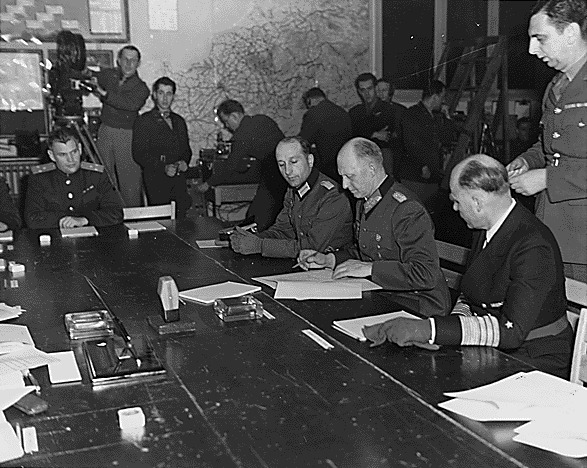
On May 6, 1945, Hermann Göring surrendered to U.S. General Carl Spaatz at the Germany-Austria border. General Hermann Niehoff surrendered Breslau to the Soviets after a prolonged siege.
On May 7, 1945, General Alfred Jodl signed the unconditional surrender of all German forces at SHAEF headquarters in Reims, France. The next day, Field Marshal Wilhelm Keitel signed another surrender document in Berlin, ending the war in Europe.
Liberation of concentration camps

As Allied forces advanced into Germany in 1945, they began to uncover the horrifying scale of the Holocaust. They discovered numerous Nazi concentration camps and forced labor facilities.
On April 15, 1945, the British 11th Armoured Division liberated Bergen-Belsen, where they found up to 60,000 prisoners. Four days later, American troops from the 42nd Infantry Division liberated Dachau.
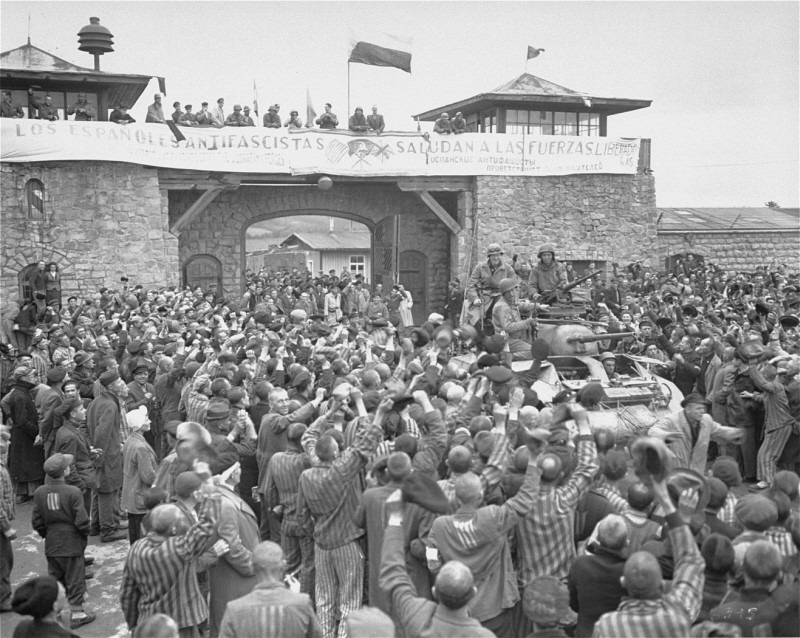
Allied soldiers made the remaining SS guards gather the corpses and bury them in mass graves. Despite the liberation, thousands of prisoners continued to die due to their poor physical condition.
Captured SS guards were tried at Allied war crime tribunals, with many sentenced to death. However, up to 10,000 Nazi war criminals escaped Europe through ratlines, evading justice.
Aftermath of Nazi Germany

On May 8, 1945, the Channel Islanders were informed that the war was over. British Prime Minister Winston Churchill announced the end of hostilities in a radio broadcast.
The war had left Germany in ruins, leading to its occupation by Allied forces and its eventual division into East and West Germany. These events marked the end of the Third Reich and the conclusion of World War II in Europe.
More pictures of Nazi Germany’s final days
1. A heavily armed German soldier carrying ammunition boxes forward during the German counter-offensive in the Belgium-Luxembourg salient on January 2, 1945
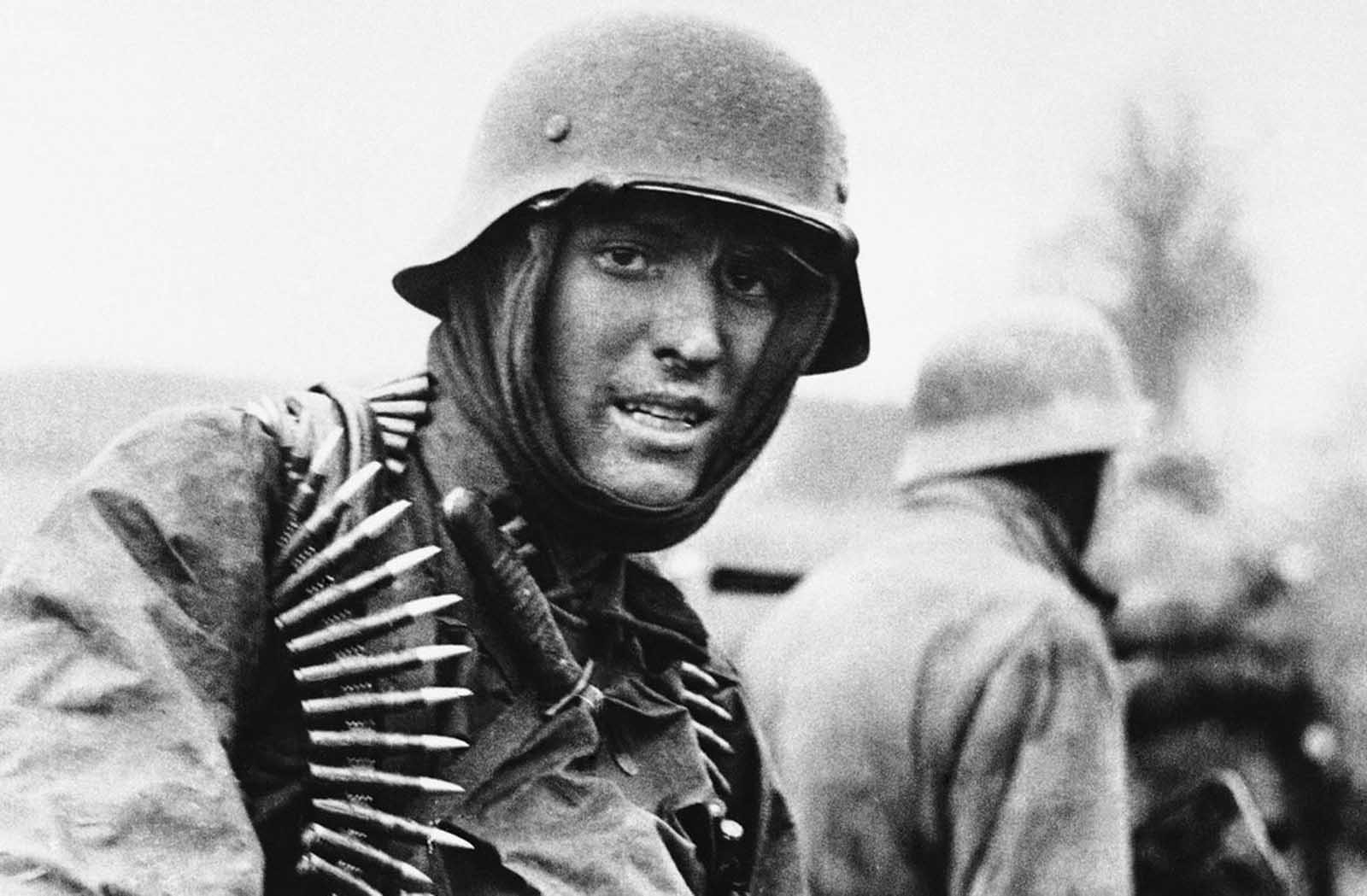
2. German soldiers standing in the debris-filled streets of Bastogne, Belgium, on January 9, 1945, after being captured by the U.S. 4th Armored Division
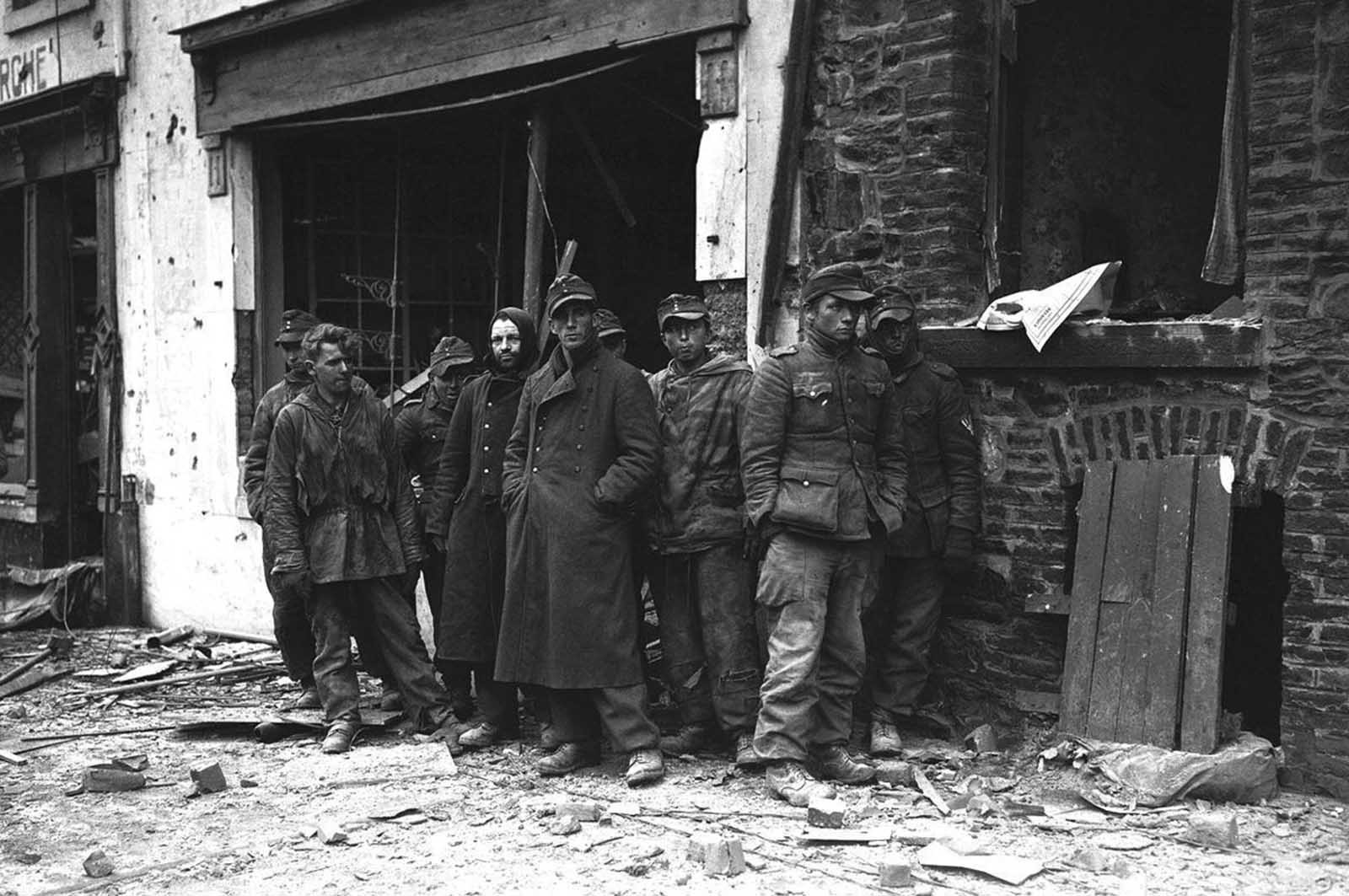
3. Low-flying C-47 transport planes roaring overhead, carrying supplies to the besieged American forces battling the Germans at Bastogne on January 6, 1945, in Belgium
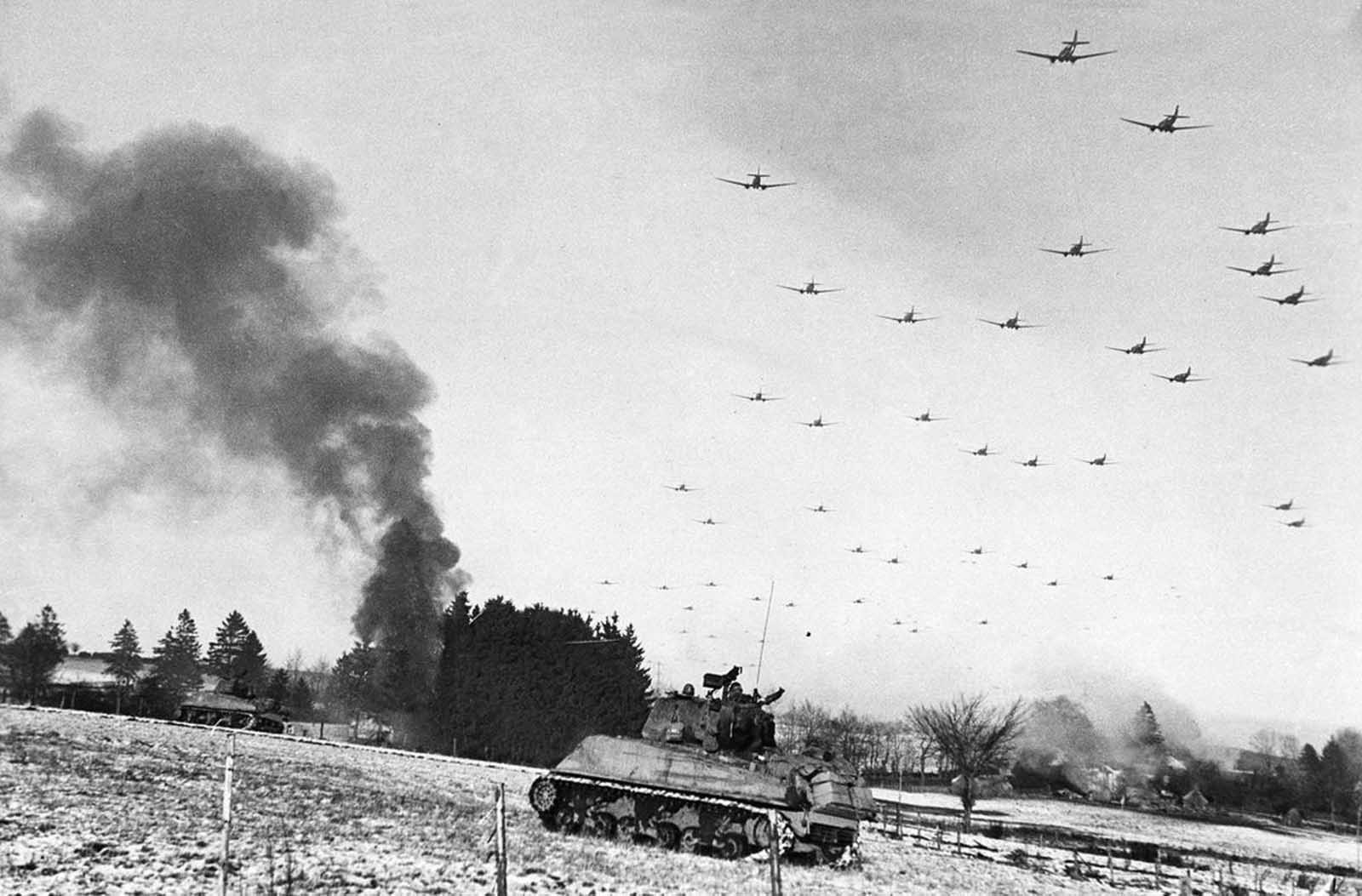
In the distance, smoke rises from destroyed German equipment while American tanks move up in the foreground to support the infantry in the fighting.
4. Refugees on a street in La Gleize, Belgium, on January 2, 1945, waiting to be transported from the war-torn town after its recapture by American forces during the German thrust in the Belgium-Luxembourg salient
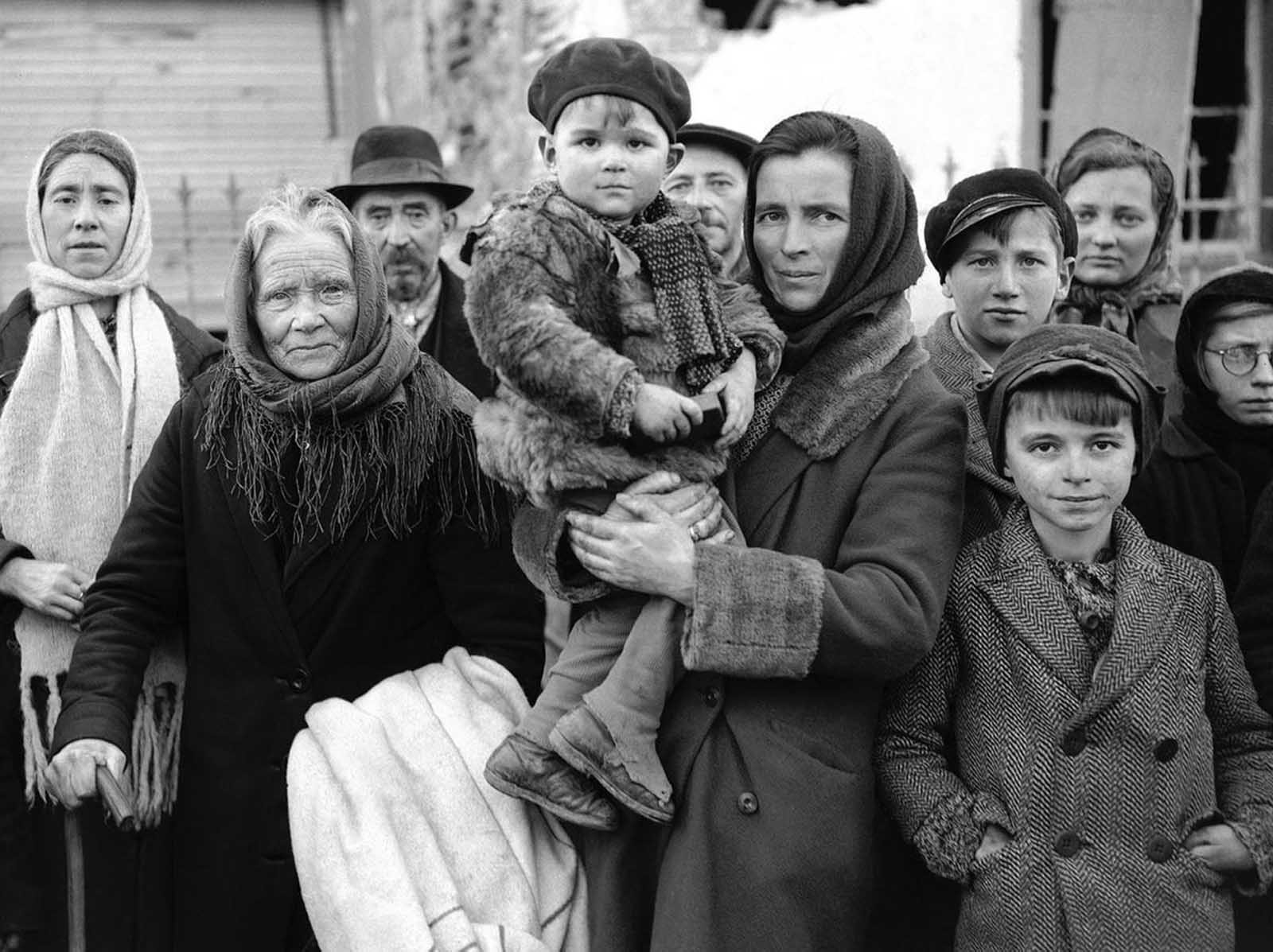
5. A dead German soldier, killed during the German counteroffensive in the Belgium-Luxembourg salient, left on a street corner in Stavelot, Belgium, on January 2, 1945, as the Battle of the Bulge continued to move forward
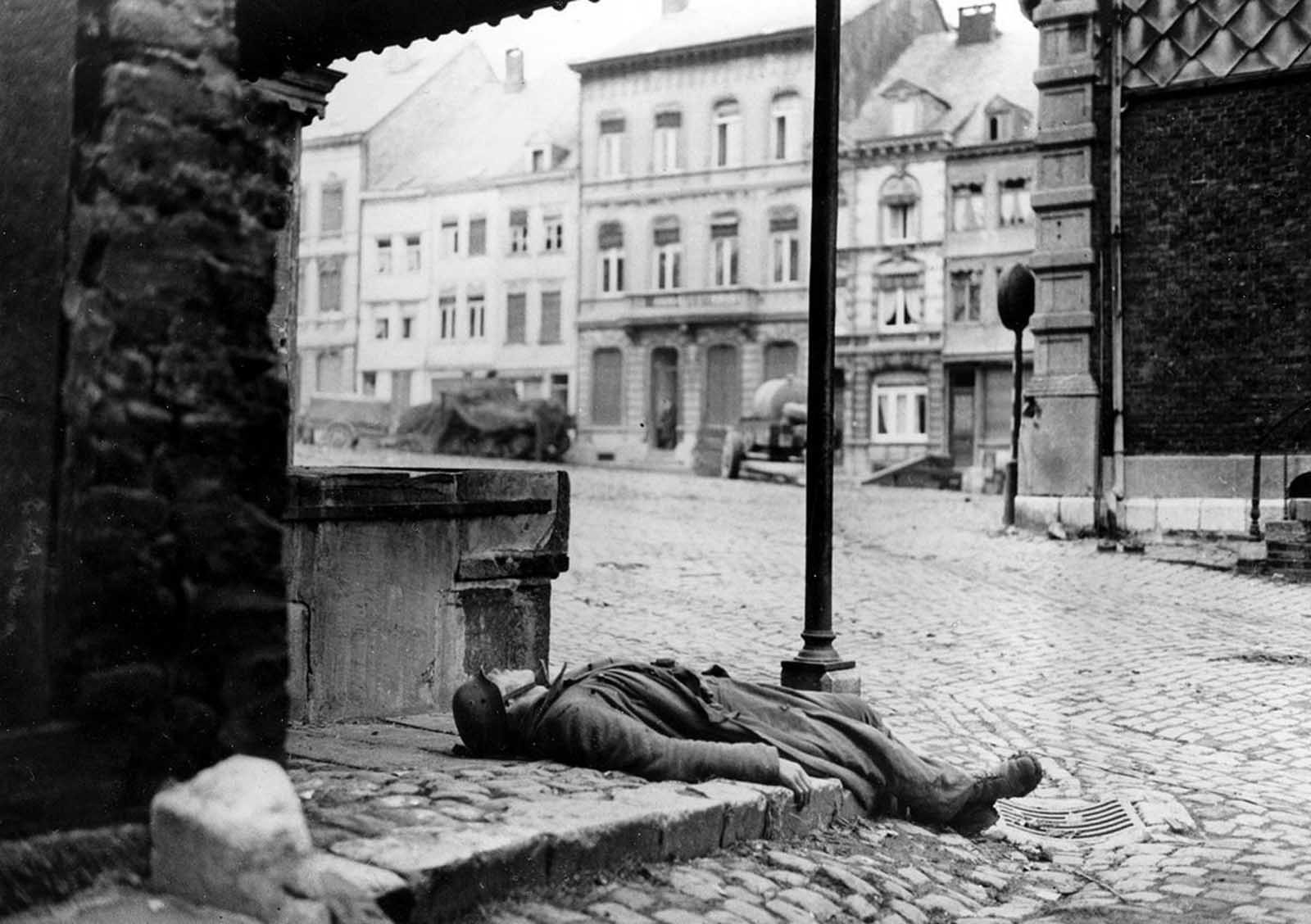
6. From left, British Prime Minister Winston Churchill, U.S. President Franklin Roosevelt, and Soviet Premier Josef Stalin sitting on the patio of Livadia Palace in Yalta, Crimea, February 4, 1945
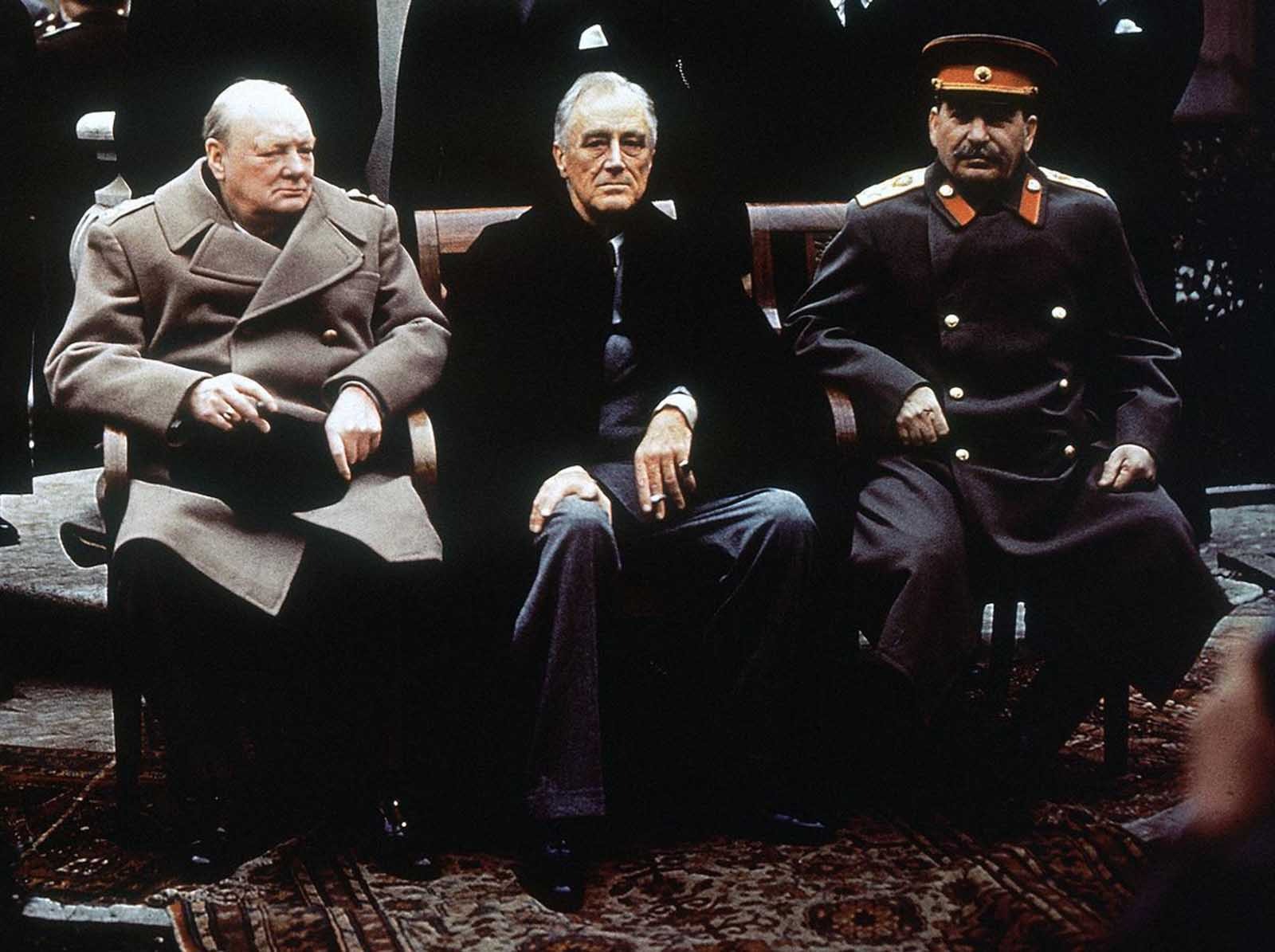
The three leaders met to discuss the post-war reorganization of Europe and the future of Germany.
7. Soviet troops of the 3rd Ukrainian Front in combat among the buildings of Budapest, the Hungarian capital, on February 5, 1945
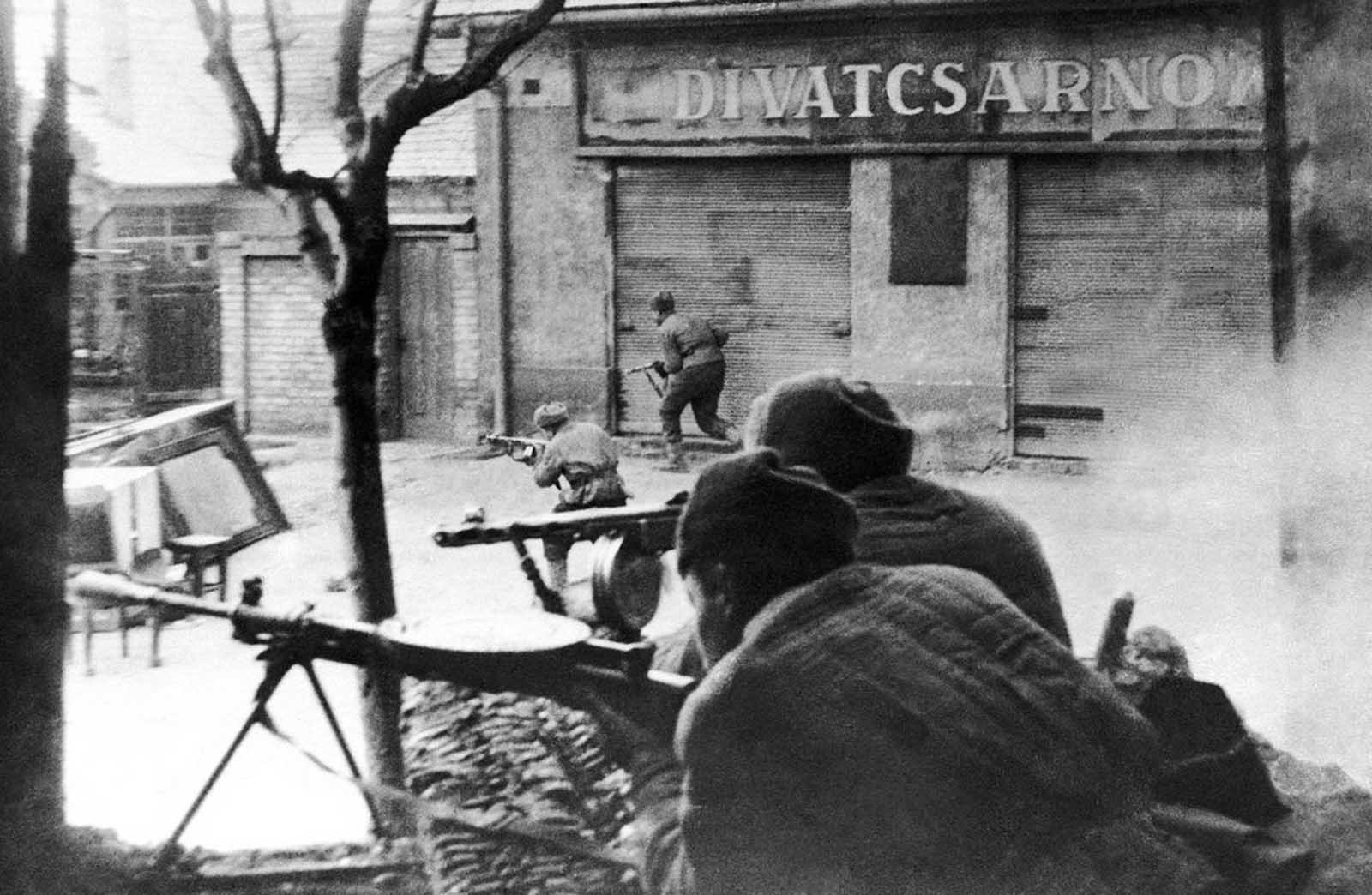
8. A V-1 “buzzbomb” plunging toward central London
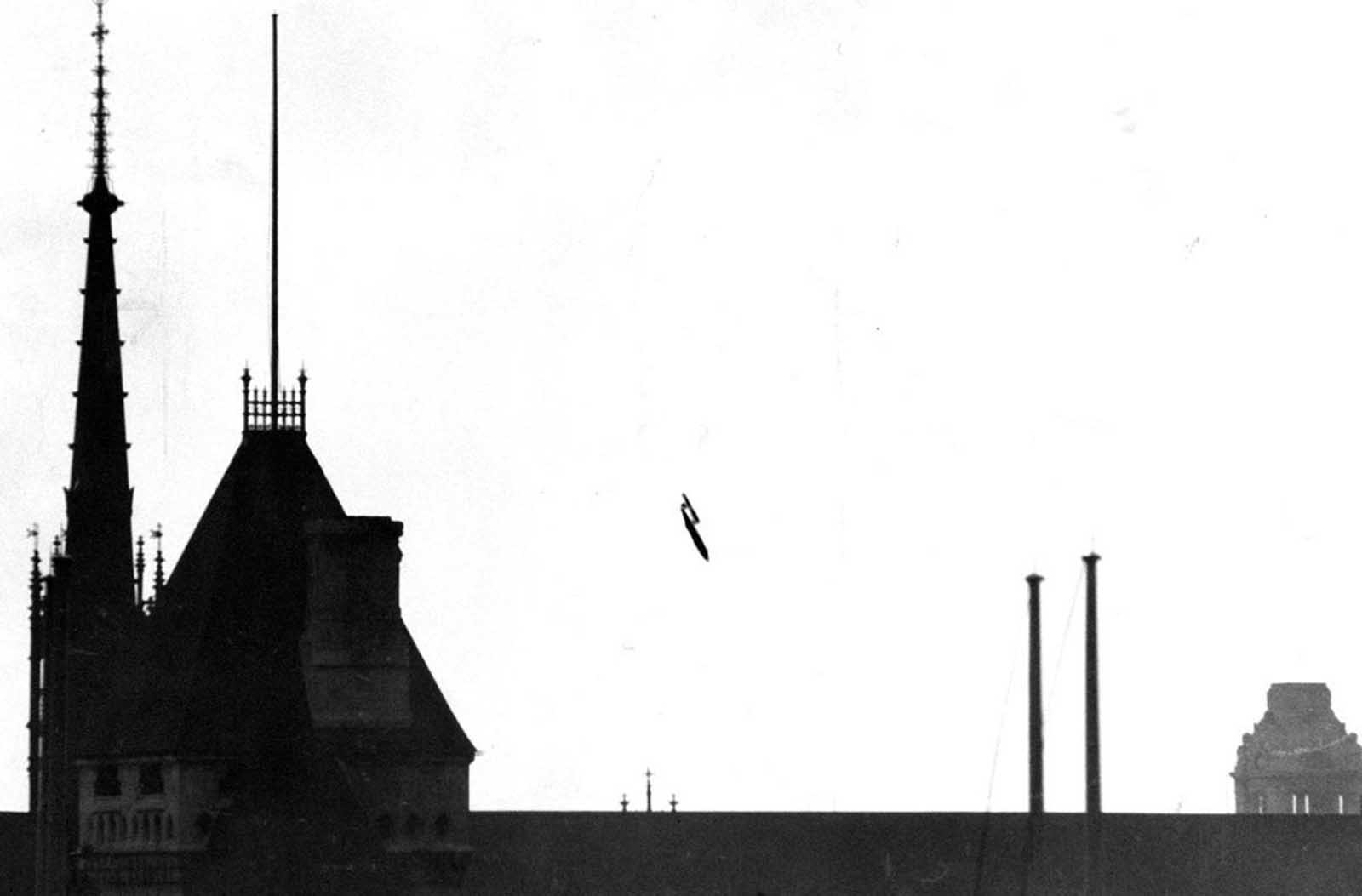
Across the Channel, Britain was under constant bombardment by thousands of V-1 and V-2 bombs launched from German-controlled areas. This photo, taken from a Fleet Street rooftop, shows a V-1 “buzzbomb” plunging toward central London.
The distinctive skyline of London’s law courts clearly identifies the scene. The bomb fell on a side road off Drury Lane, blasting several buildings, including the office of the Daily Herald.
The last enemy action on British soil was a V-1 attack that hit Datchworth in Hertfordshire on March 29, 1945.
9. A Volksopfer street collection depot
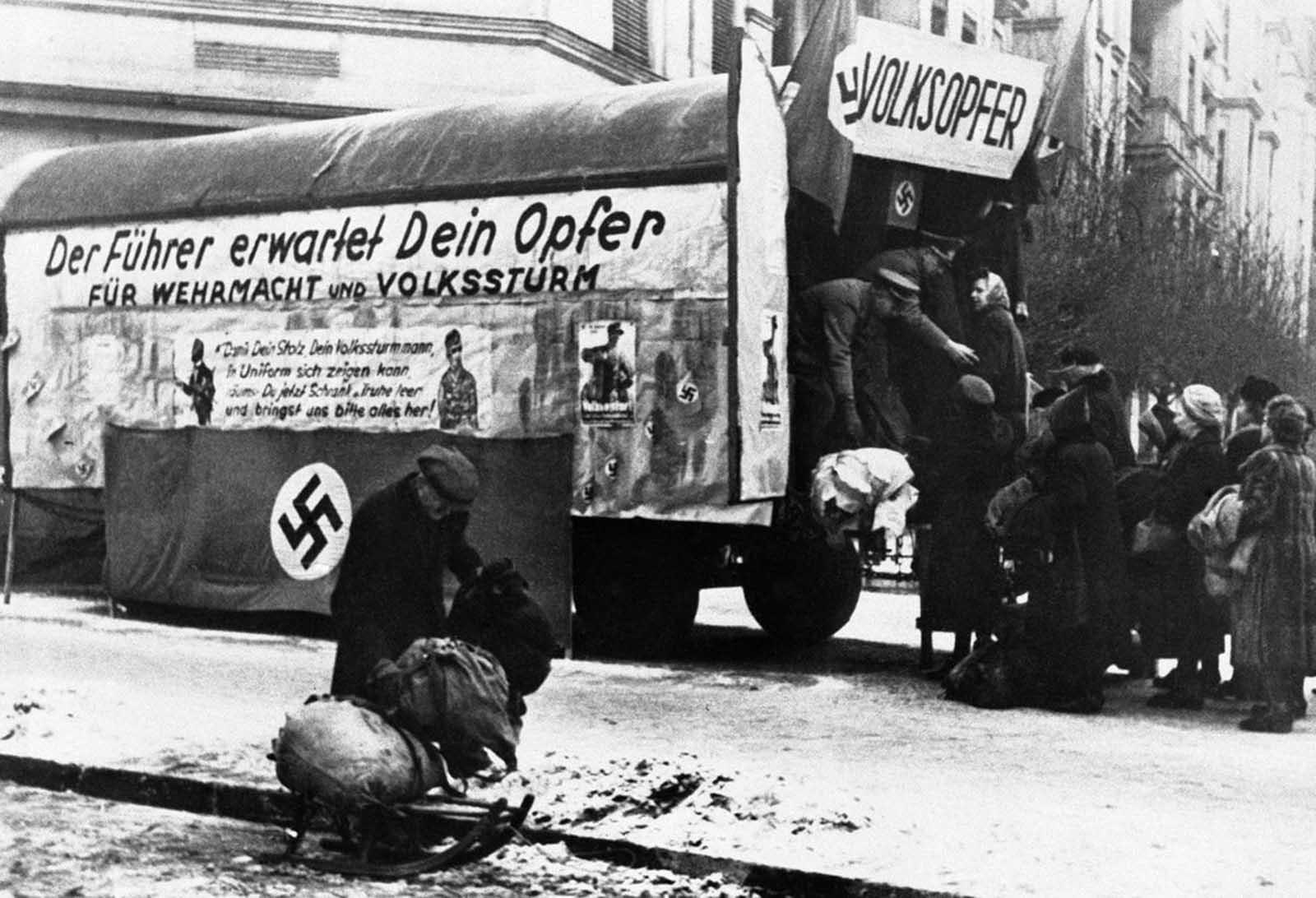
With more members of the Volkssturm (Germany’s National Militia) being sent to the front lines, German authorities faced a growing shortage of military equipment and clothing.
In a desperate attempt to address this, street collection depots called Volksopfer, meaning “Sacrifice of the People,” were set up across the country. These depots collected uniforms, boots, and equipment from German civilians.
In Berlin, on February 12, 1945, the Volksopfer bore signs saying, “The Fuhrer expects your sacrifice for Army and Home Guard. So that you’re proud your Home Guard man can show himself in uniform – empty your wardrobe and bring its contents to us.”
10. The main road in Kranenburg amid four-foot-deep floods on February 22, 1945
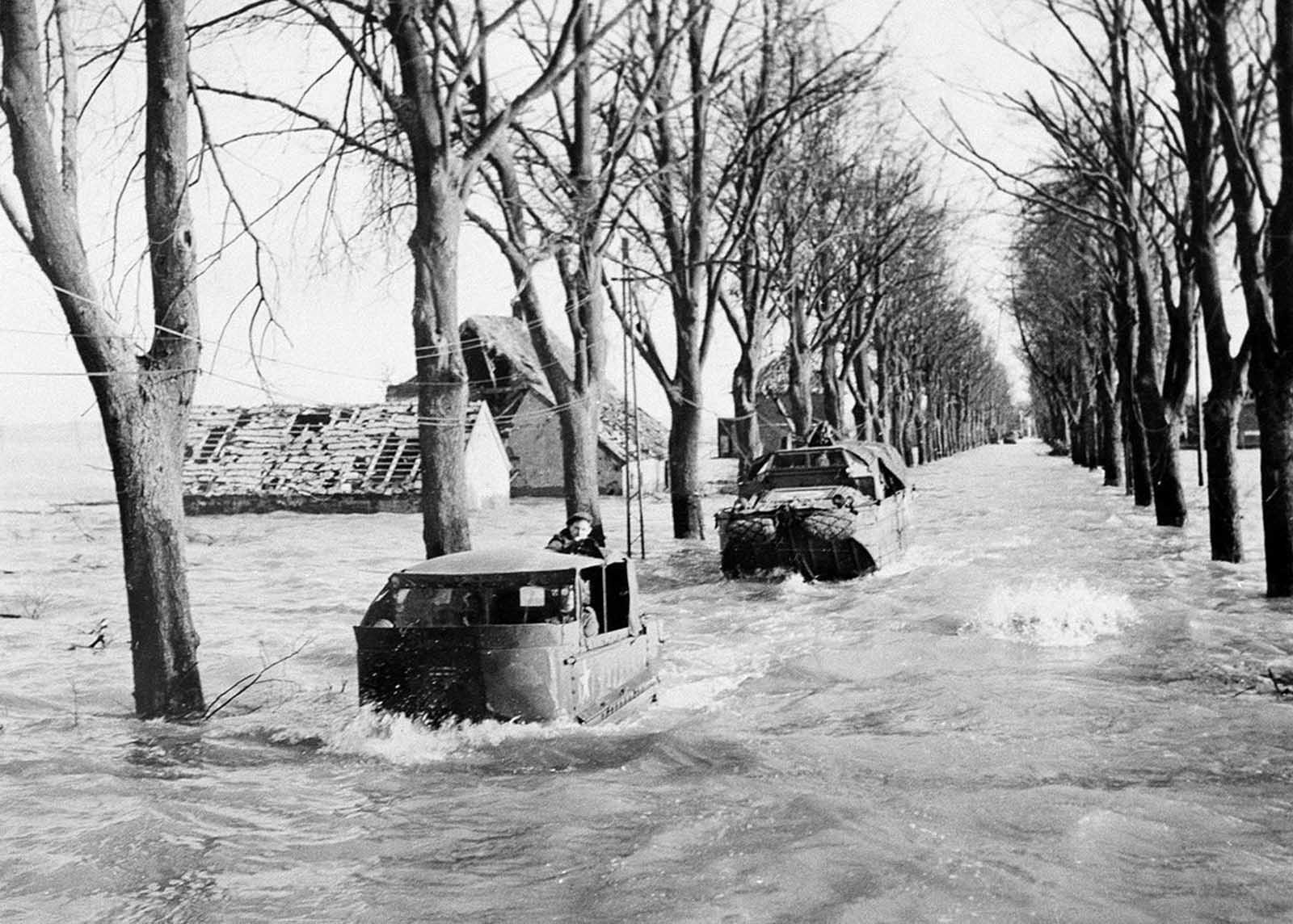
A team sets out to repair telephone lines on the main road in Kranenburg on February 22, 1945, amid four-foot-deep floods caused by the retreating Germans who had burst dikes. During these floods, British troops went deeper into Germany and had their supplies delivered by amphibious vehicles.
11. A 16-year-old German soldier crying after he was captured by U.S. forces in Germany in 1945
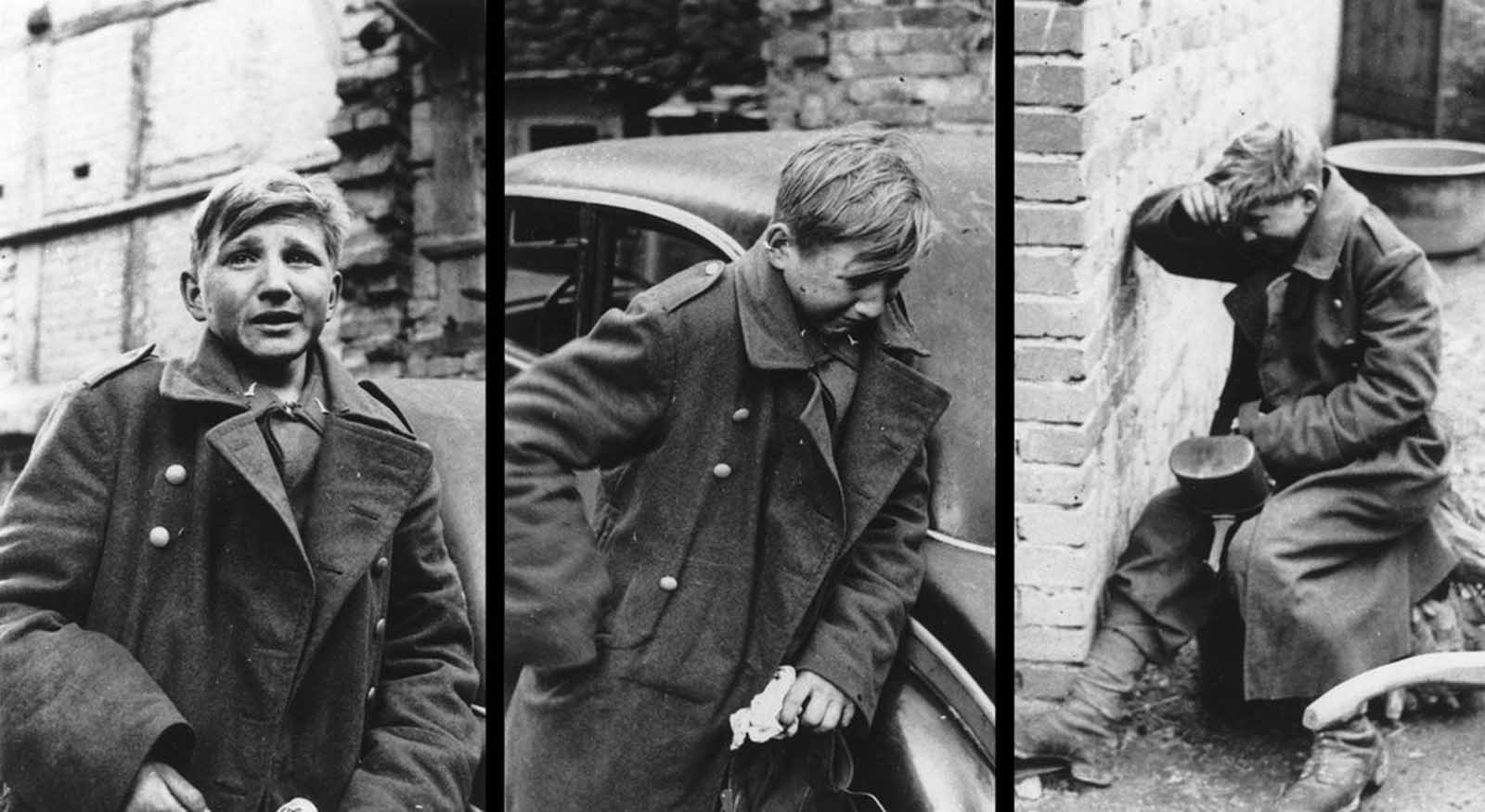
12. Flak bursting through the vapor trails from B-17 Flying Fortresses of the 15th Air Force during an attack on the rail yards at Graz, Austria, on March 3, 1945
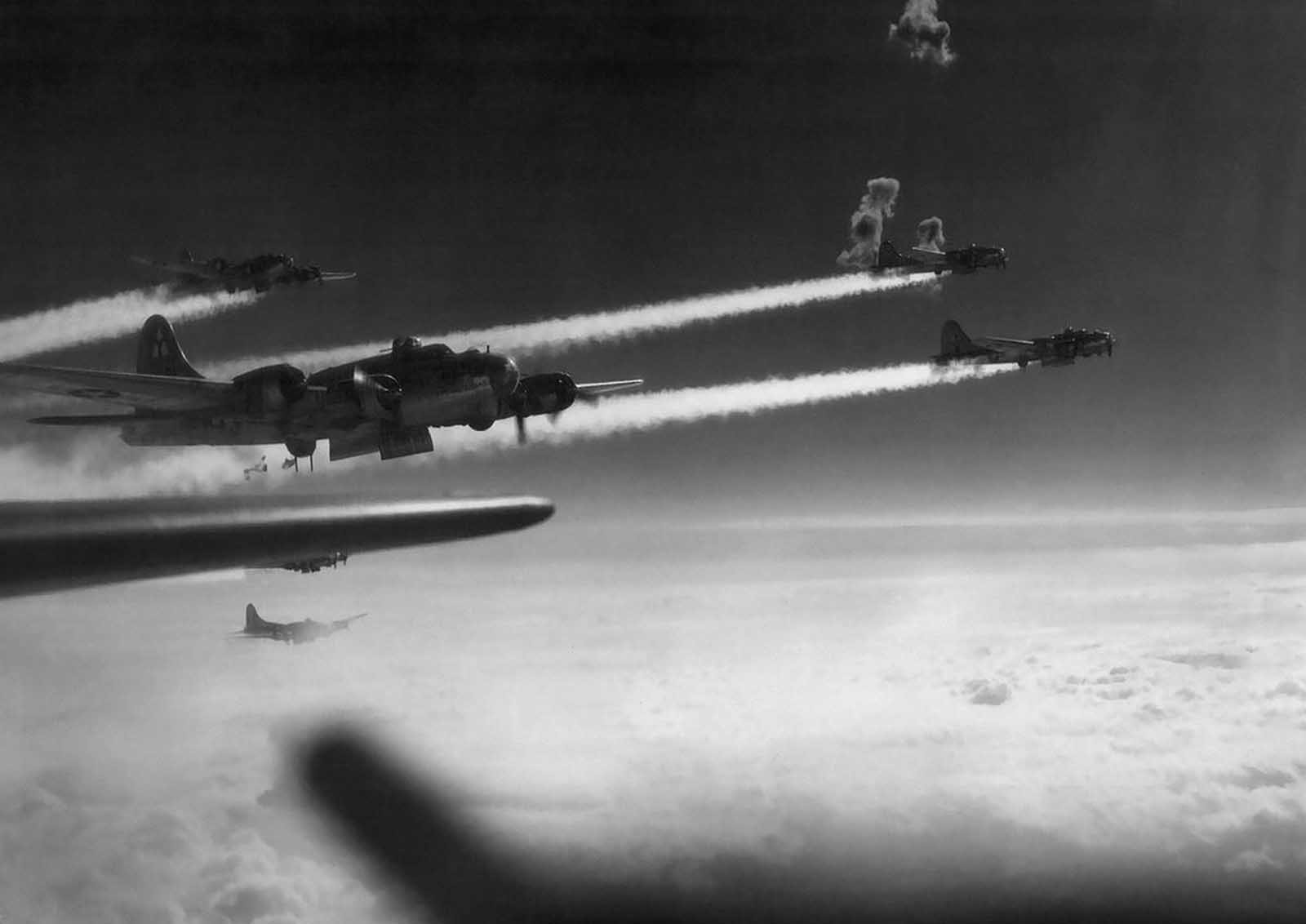
13. A view from Dresden’s town hall shows the destroyed Old Town after the Allied bombings between February 13 and 15, 1945
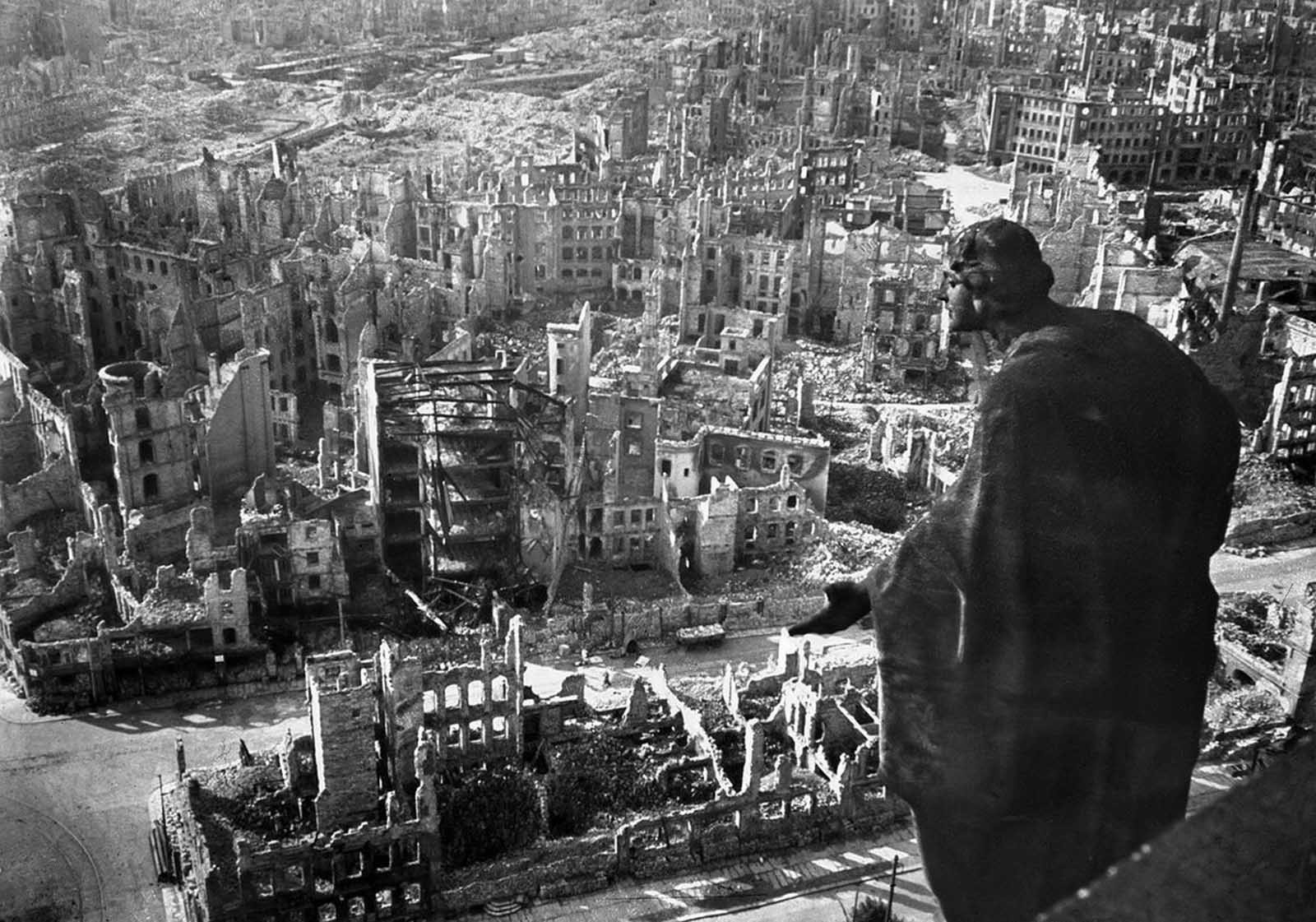
Around 3,600 aircraft dropped more than 3,900 tons of high-explosive bombs and incendiary devices on the German city. The resulting firestorm destroyed 15 square miles of the city center and killed over 22,000 people.
14. Soldiers of the 3rd U.S. Army storm into Coblenz, Germany, as a dead comrade lies against the wall, on March 18, 1945
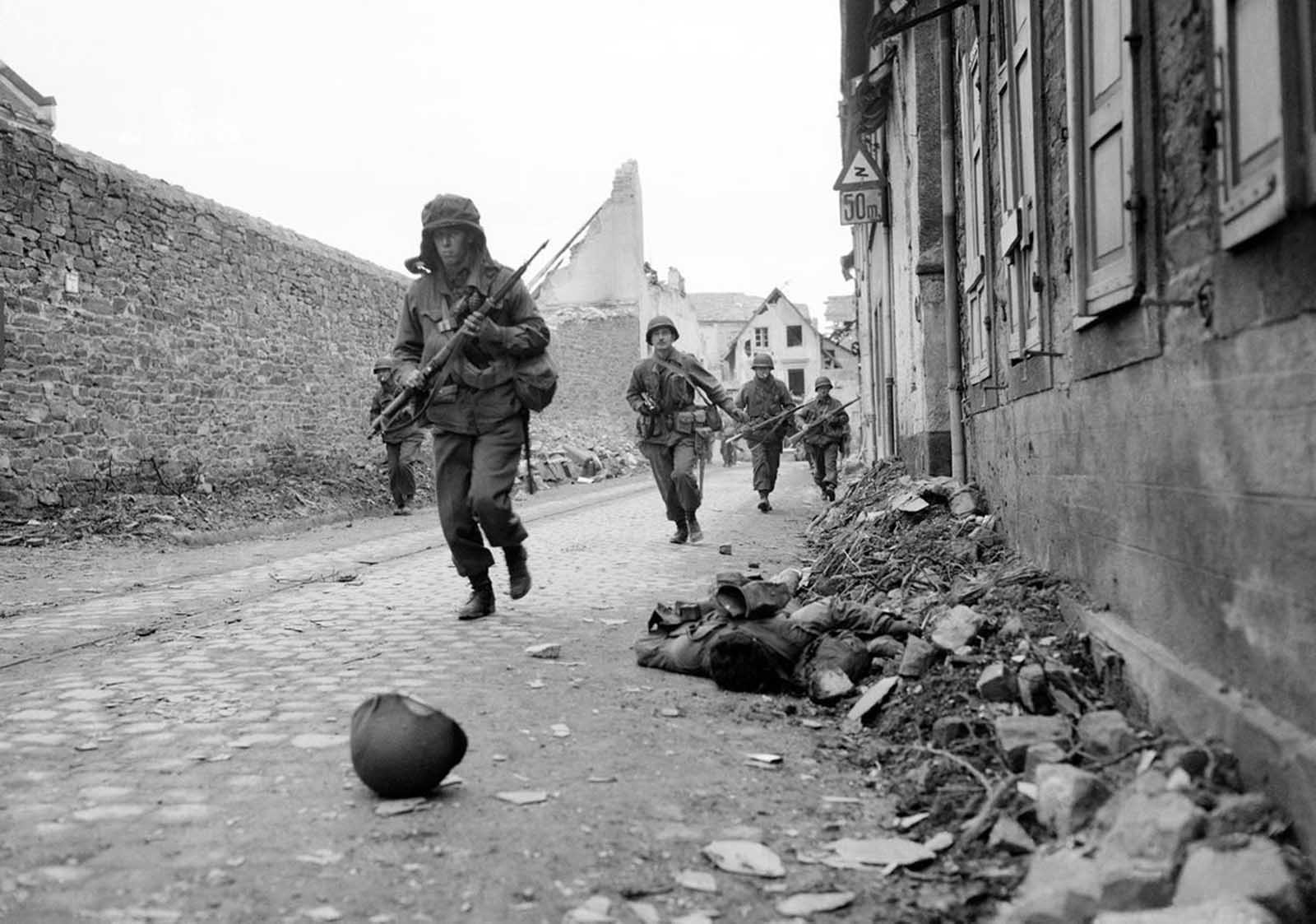
15. Men of the American 7th Army pour through a breach in the Siegfried Line defenses, on their way to Karlsruhe, Germany, on March 27, 1945, which lies on the road to Stuttgart

16. Jewish services in Schloss Rheydt
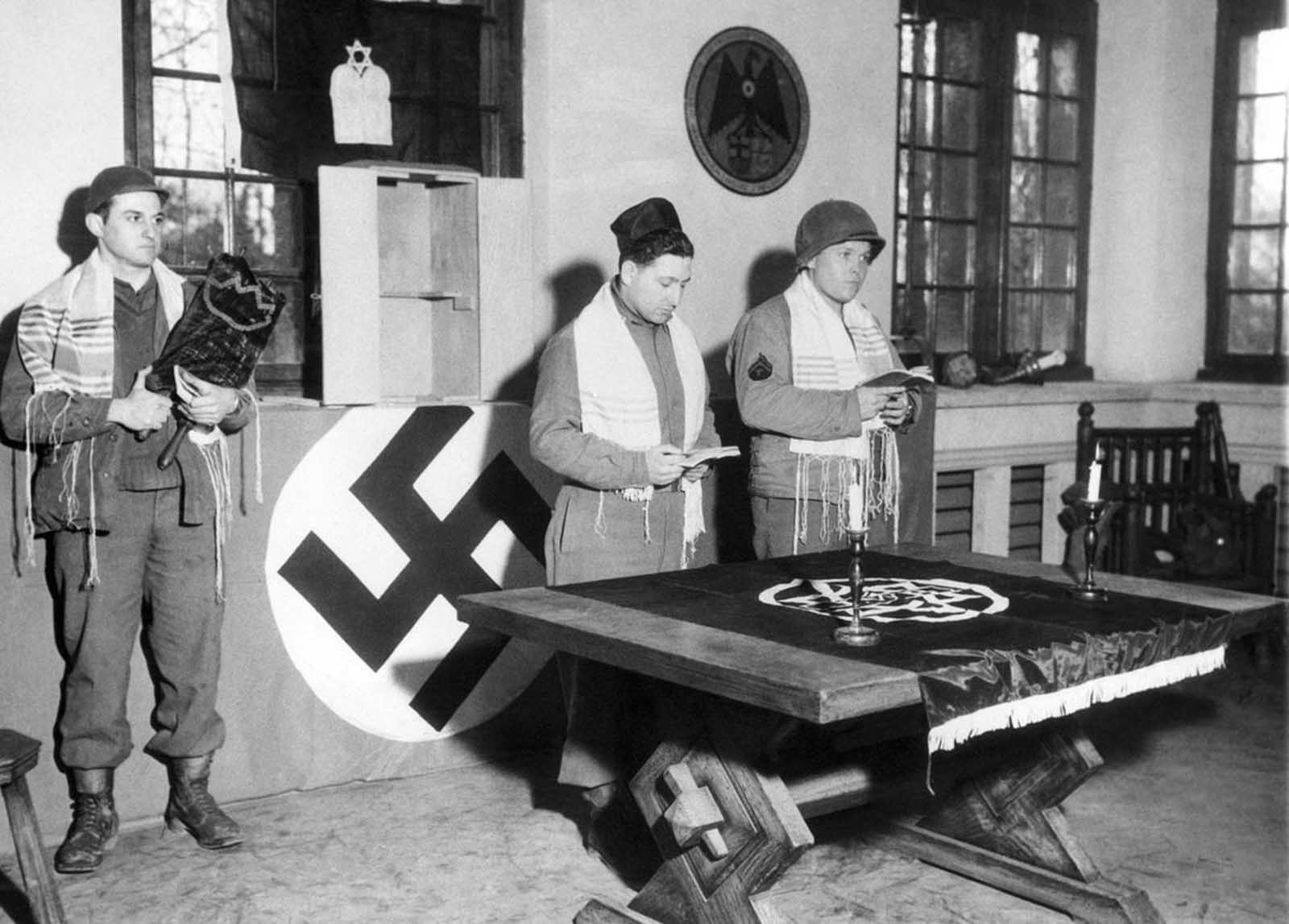
On March 18, 1945, Pfc. Abraham Mirmelstein of Newport News, Virginia, held the Holy Scroll as Capt. Manuel M. Poliakoff and Cpl. Martin Willen, both from Baltimore, Maryland, conducted Jewish services in Schloss Rheydt, the former residence of Nazi propaganda minister Dr. Joseph Goebbels.
These were the first Jewish services held east of the Rur River and were offered in memory of the soldiers of the faith lost by the 29th Division, U.S. 9th Army.
17. War-torn Cologne Cathedral of the devastated area on the west bank of the Rhine, in Cologne, Germany, on April 24, 1945
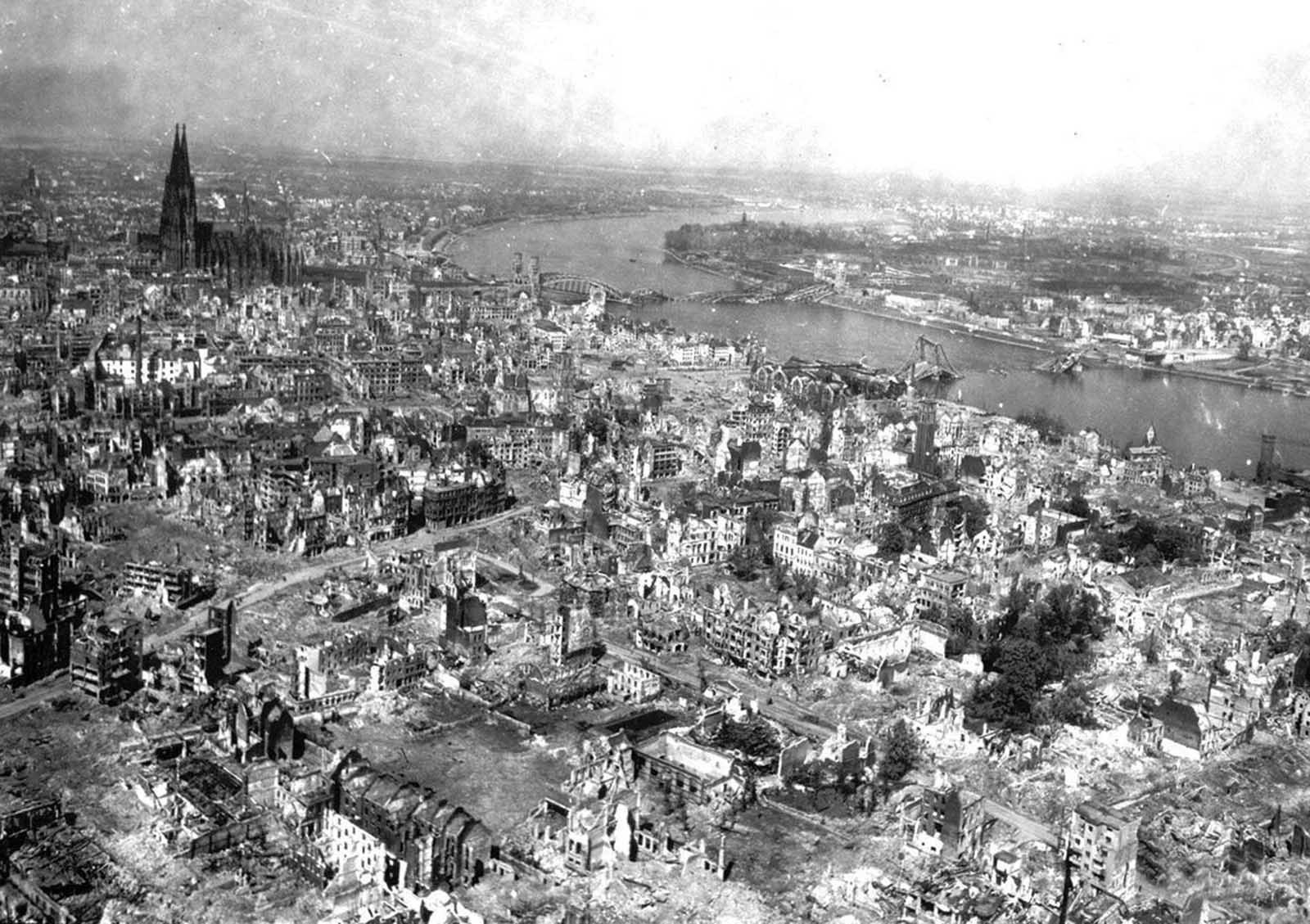
The railroad station and the Hohenzollern Bridge, at right, are completely destroyed after three years of Allied air raids.
18. An American soldier of the 12th Armored Division guarding over a group of German soldiers, captured in April 1945 in a forest at an unknown location in Germany.
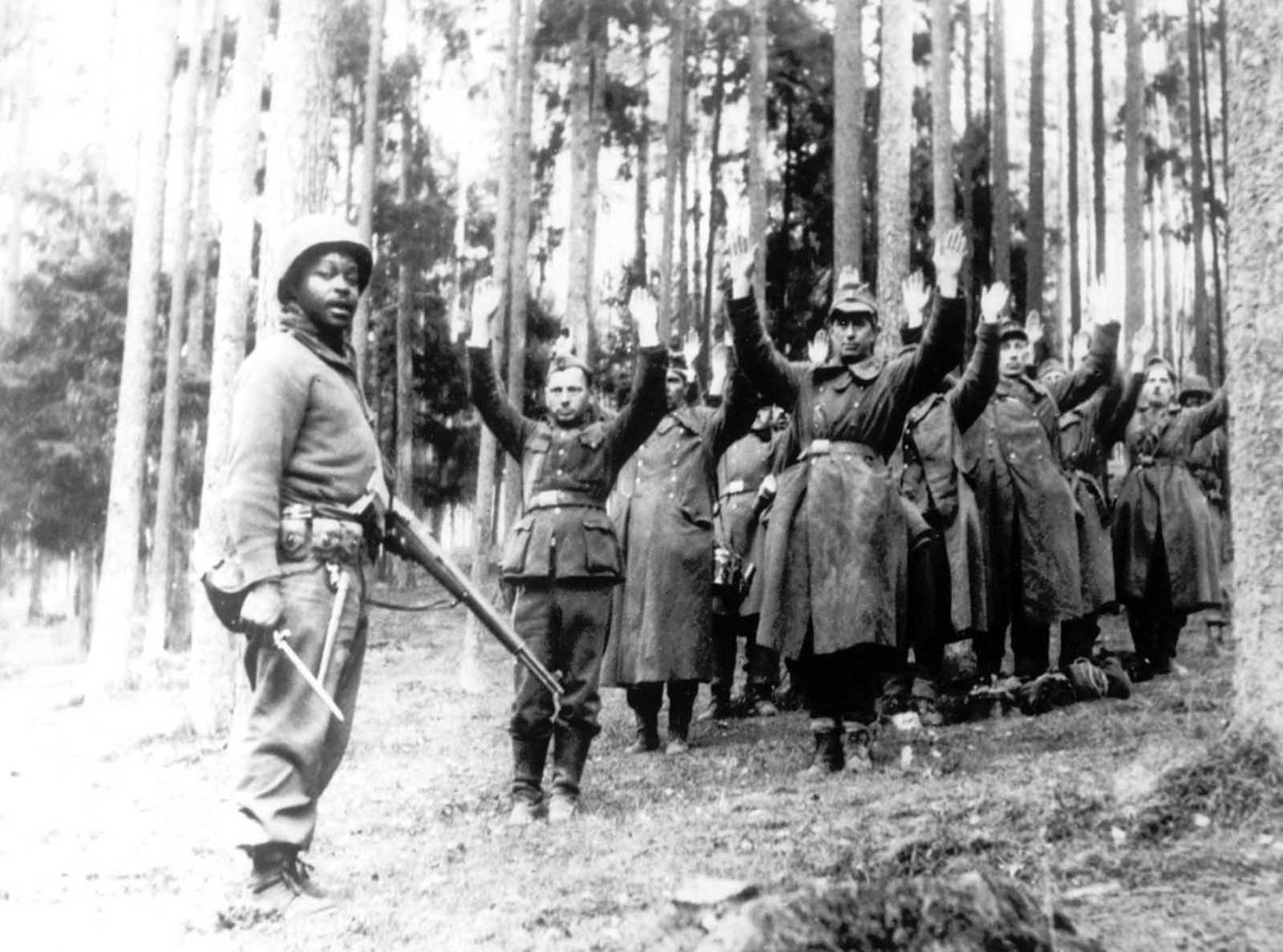
19. Adolf Hitler decorating members of his Nazi youth organization “Hitler Jugend”, reportedly taken in front of the Chancellery Bunker in Berlin, on April 25, 1945

20. Partly completed Heinkel He-162 jet fighters on the assembly line in the underground Junkers factory at Tarthun, Germany, in early April 1945.

21. Soviet officers and U.S. soldiers during a friendly meeting on the Elbe River in April of 1945
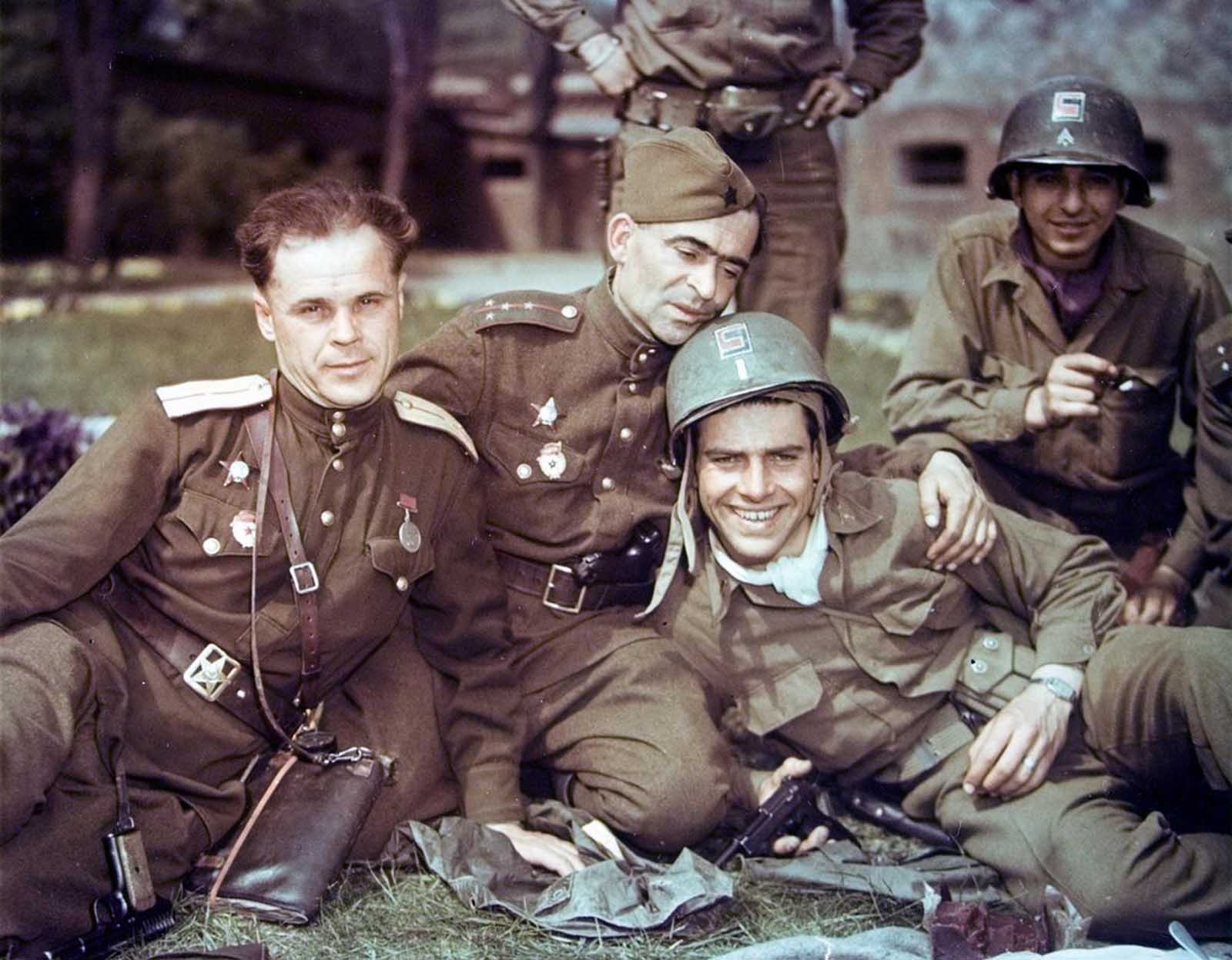
22. An over-crowded cage of Germans rounded up by the Seventh Army during its drive to Heidelberg, on April 4, 1945

23. A U.S. soldier amid the rubble in the Monument to the Battle of the Nations in Leipzig after attacking the city, April 18, 1945
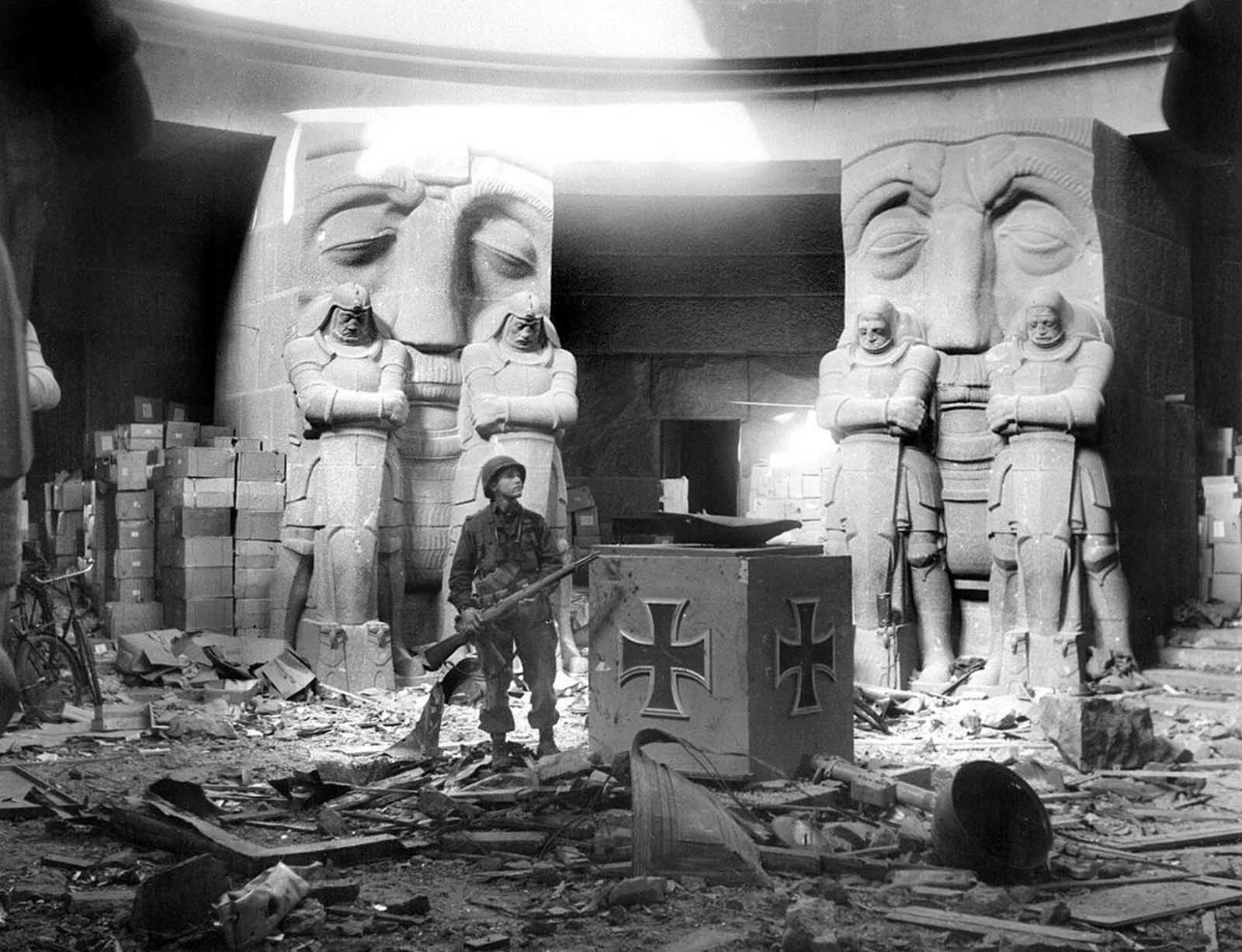
24. Soviet soldiers leading house-to-house fighting in the outskirts of Königsberg, East Prussia, Germany, in April of 1945
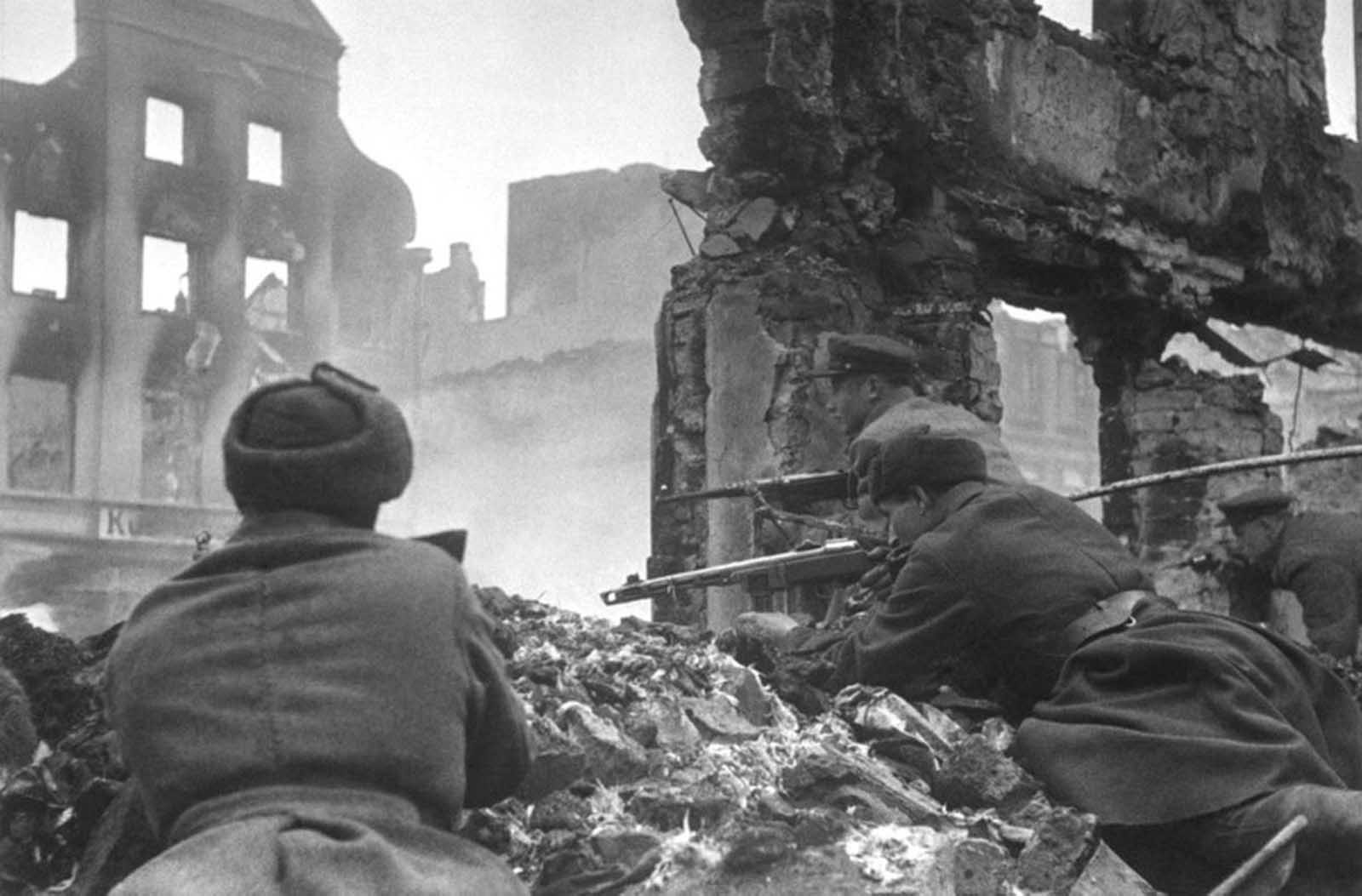
25. A German officer eating C-rations amid the ruins of Saarbrücken, a German city and stronghold along the Siegfried Line, in the early spring of 1945
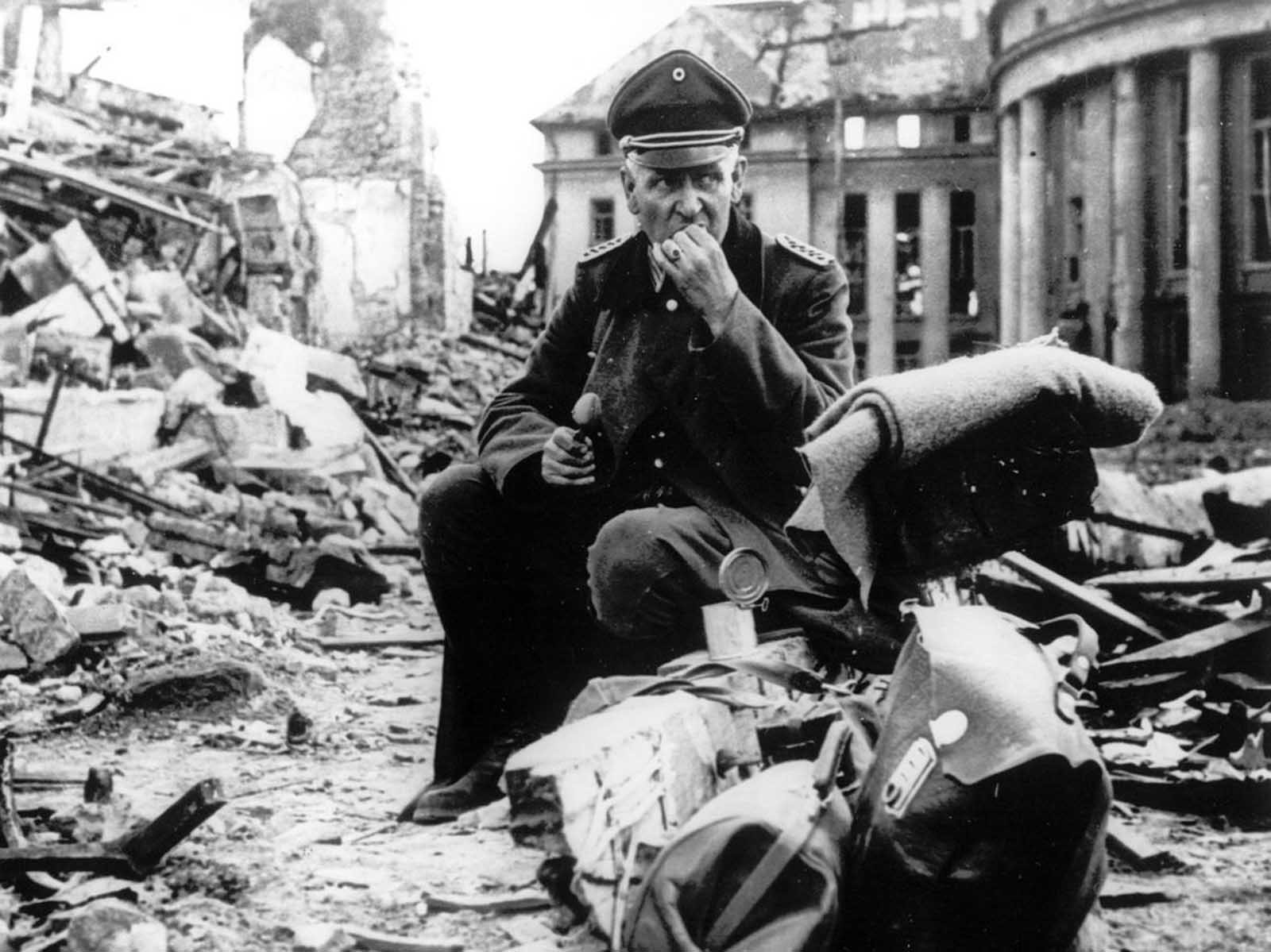
26. Overwhelmed with emotion, this Czech mother kissed a Russian soldier in Prague, Czech Republic on May 5, 1945, thanking one who fought to free her beloved home

27. The subway rush hour brought to a standstill in New York City, May 1, 1945 as the report of Hitler’s death was received

28. A seething mass of humanity jammed itself into Whitehall in central London on VE-Day (Victory in Europe Day), May 8, 1945, to hear the premier officially announce Germany’s unconditional surrender

29. Looking north from 44th Street, New York’s Times Square on Monday, May 7, 1945, with crowds celebrating the news of Germany’s unconditional surrender in World War II
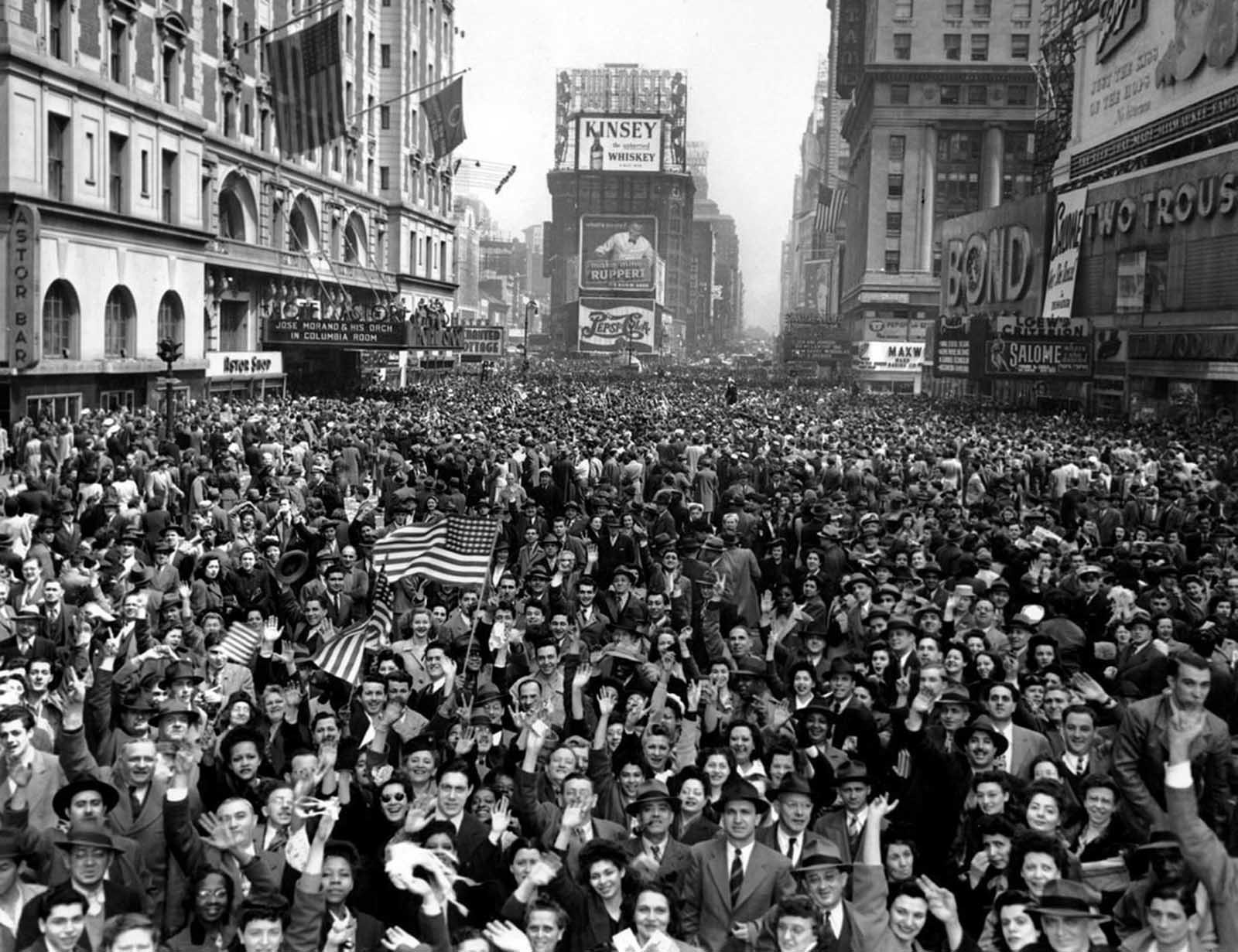
30. Celebration of Victory in Moscow’s Red Square, in the Soviet Union. Fireworks began on May 9, 1945, followed by bursts of gunfire and a sky illuminated by searchlights

31. The wrecked Reichstag building in Berlin, Germany, with a destroyed German military vehicle in the foreground, at the end of World War II

32. Soviet Ilyushin Il-2 ground attack aircraft in the skies above Berlin, Germany in 1945
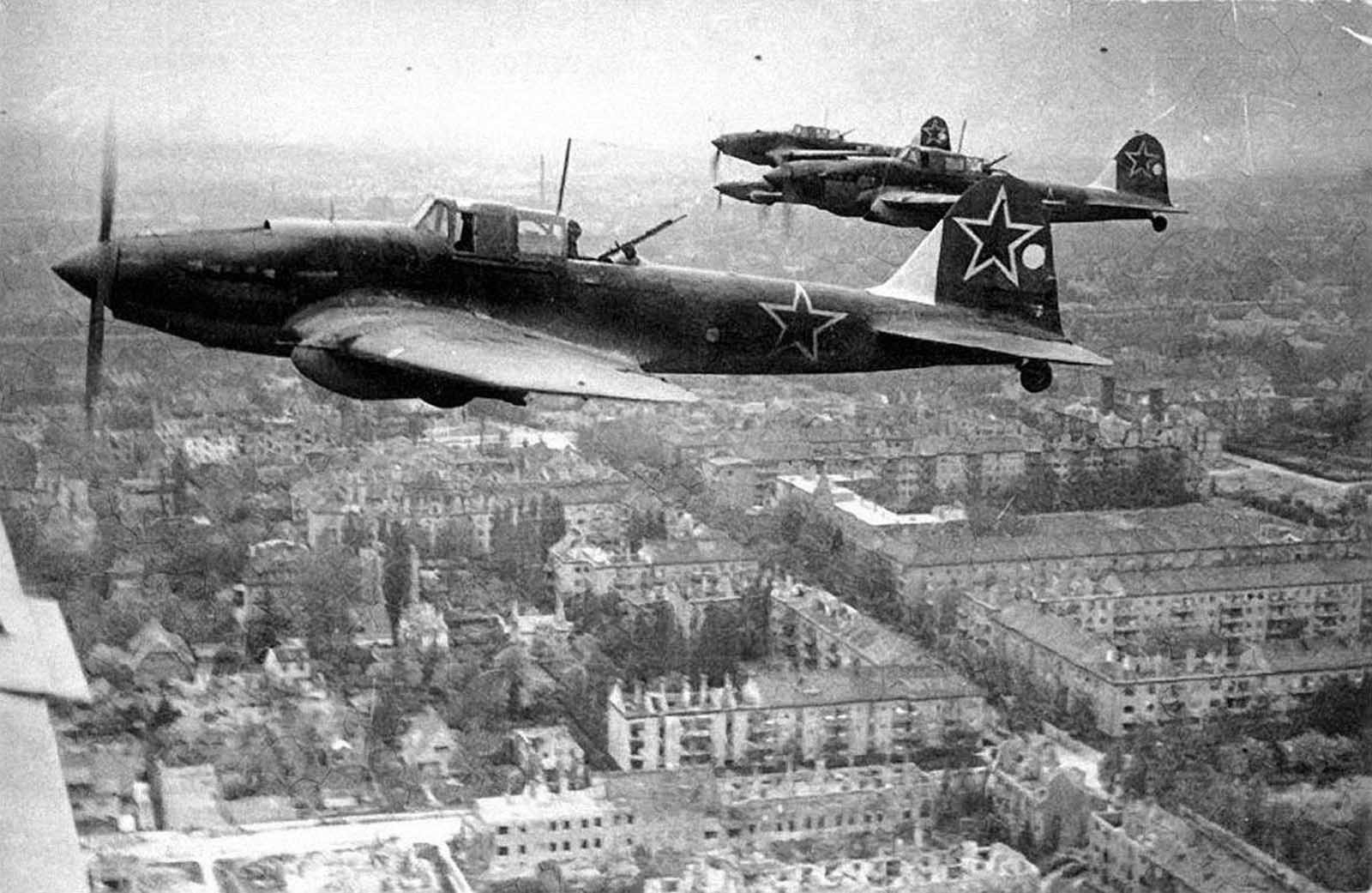
33. A color photograph of the bombed-out historic city of Nuremberg, Germany, in June of 1945, after the end of World War II
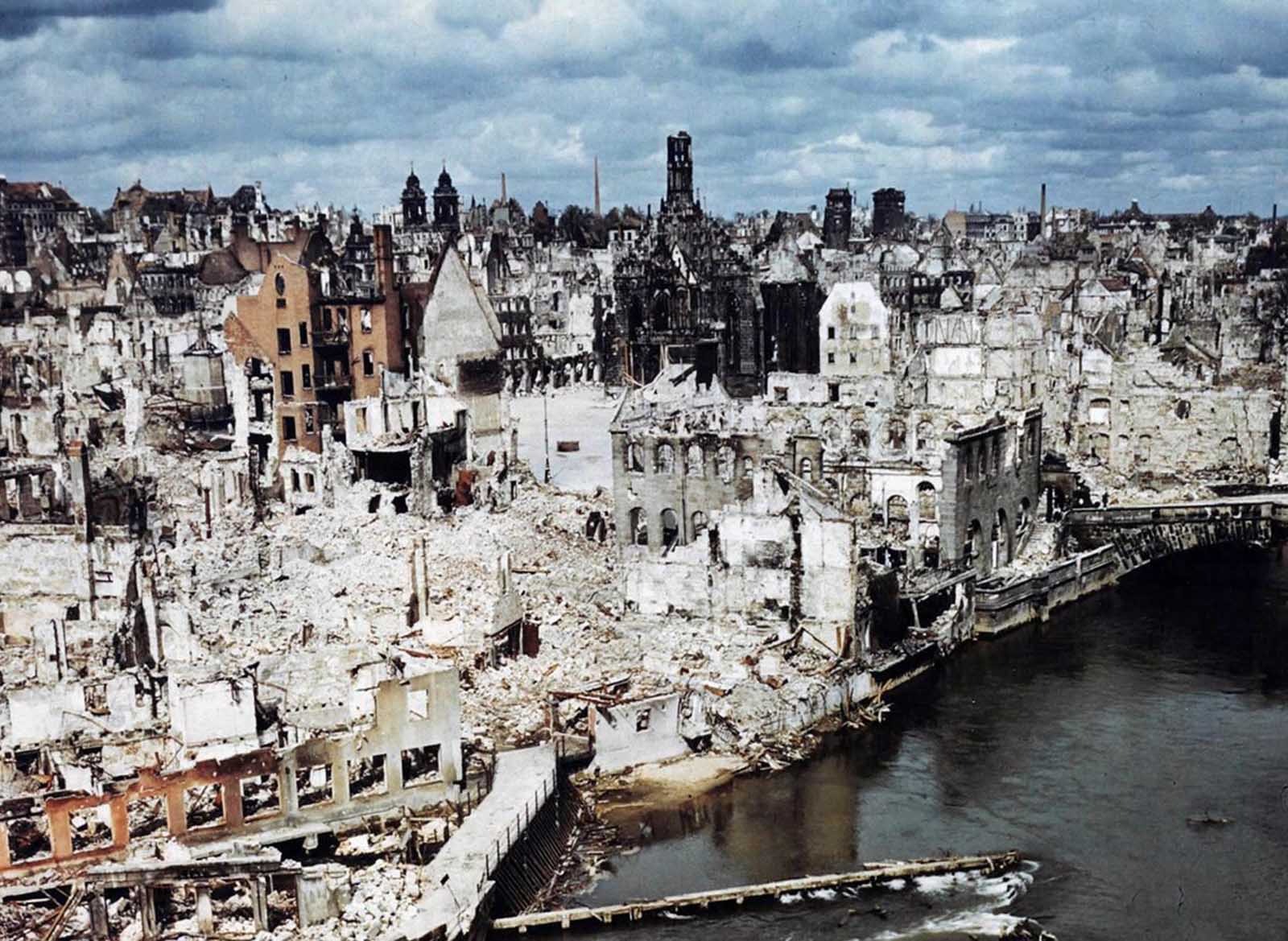
Nuremberg, known for hosting massive Nazi Party rallies from 1927 to 1938, was also the birthplace of the Nuremberg Laws, a set of harsh antisemitic regulations enacted by Nazi Germany.
The last rally, scheduled for 1939, was canceled due to the German invasion of Poland one day prior. Allied bombings from 1943 to 1945 destroyed more than 90% of the city center and killed over 6,000 residents.
Nuremberg later gained notoriety as the site of the Nuremberg Trials, military tribunals that prosecuted surviving Nazi leaders for war crimes, including “Crimes Against Humanity,” which encompassed the systematic murder of over 10 million people, including approximately 6 million Jews.

